copyright 2008
I like a lot of different styles of painting. I have had an active interest in art for the past few years, and my tastes are still evolving as I learn and live with my growing collection. I do not collect as an investment but for the fun of it and to feed my enjoyment for doing research and learning. Here are some of my favorites. By the way, I am NOT the wildlife artist of the same name.
I am no longer maintaining this page as it had grown so large that is was causing some browsers to die a horrible death, lock up or just respond very slowly. This page has now been broken up into three pages, of which only "Unknown Artists 3" will be updated. Needless to say there may be one day be a page 4, 5, etc. Once I am certain that I did not miss adding anything on this page to one of the other Unknown Artists pages, I will archive this page. Sorry for any inconvenience. Kevin
Pennsylvania Artists Texas Artists New England Artists Other Artists
UK Artists Canadian Artists South American Artists Asian Artists European Artists
Unknown Artists Unknown Artists 1 Unknown Artists 2 Unknown Artists 3
HOME

unnamed, unknown, 20" x 28", oil on board
Here is
an ebay find for which it is possible I will never know
more about than I do right now.
Here is what the Lithuanian seller, D. Vabolio
Enterprises had to say about it:
"I
bought it in Latvia Riga. The owner said what here is
Riga art academy interior view, was created by Russian
artist, but not signed."
The seller probably meant the Riga
Art School. I sent an email to the school to see if anyone
recognizes he work of this artist and received the
following reply from Dr. Kristiana Abele:
"In response to your
inquiry about the studio scene reputedly created by a
Russian artist at the Academy of Art in Riga the form of
the window niche let me suggest that it could have been
painted by a student of the Riga City Art School between
1912 and 1915 when this institution had its provisional
premises in St. Jacob's Barracks (Jekaba kazarmas, Jakobs
Kaserne) at Torna Street in Riga. In the summer of 1915,
the school was closed and evacuated to be continued as the
Latvian Academy of Art already in the independent Republic
in Latvia from 1921 when it got housed in a building with
windows of a very different type. Unfortunately, the lack
of additional information makes it impossible to establish
the identity of the artist."
Jacob's Barracks is still in
existence, having been converted to commercial space and
residential housing. I contacted the real estate agents
who are the agents for the building and received a reply
that said they believed the image to be from the building.
They sent me some stock photos of the interior and
exterior.

Jacob's Barracks
I paid only $10 for this painting,
which I really like, but a subsequent offering of another
view of the same building by this same artist fetched
several hundred dollars. The second, smaller painting was
not as good as this one. I made a "Buy it now" offer that
was accepted shortly after the works were offered. I
suspect I got lucky on this purchase. Too bad it is not
signed. There were several other works by this artist from
this seller, including two or three more that depicted
scenes similar to the one in my collection, several
landscapes and figurative works.

verso
The
back of the painting shows it has some age, though maybe
not the 1900-1940 estimate of the seller. It is in very
good condition, so it may have been stored in a
favorable environment for some time.

unnamed, Paoli, 12" x 10", oil on board
This
was an ebay find. It was presented as the work of
Italian artist Bruno Paoli (1915-2005), but it bears no
resemblance to his most widely known style and the
signature is very different than any other example of
his signature that I can find. That makes this
attribution very suspect. The seller included several
printouts of previous auctions of landscape works
attributed to Paoli and one does have a signature that
bears a resemblance to the one on my painting, and is
from an Italian auction. I cannot say whether or not the
style of this painting is similar to those in the
printouts as the images are too small and indistinct. It
does not appear to be dated, similar to my painting,
though Paoli seems to have routinely dated his work from
the 1960s onward, using a very distinctive signature.
According to a biography in a gallery catalog in my
possession, Paoli originally worked as a sculptor and
only started painting in the 1950s, so this leaves a
very brief window of time for a change in his
signature.
Paoli is a very common name, with
over 700 people by that name in the 1930 census and many
more in the current national telephone listings. The
seller of this painting was located in San Diego, CA. I
suspect this identification was the result of a
Google or on line art site search for prominent
artists named Paoli, especially since the seller quoted
a biography from the Internet for Bruno Paoli. I
contacted the source for this biography, a gallery owner
who knew Paoli and represents the largest remaining
collection of his work, and she agrees that it is
doubtful that is by Paoli. This is a common ebay
scenario. It is an interesting work and the
frame had more value than I paid for the painting and
frame combined, though, and in a frame size that can be
difficult to find used.
This led to a few hours of pleasant
research regarding artists named Paoli. I restricted my
search to artists by this name in the United States,
since those are the resources that I have available.
While there are several men listed with the occupation
of "painter" in the genealogical records that I have
access to, only one, Peter Edward Paoli, was listed as
an artist. There are many kinds of painters, and several
of these men were obviously working in occupations like
house painters, etc. Peter Paoli, on the other hand, was
listed as an artist in many records from 1910 through
the 1940s. He was listed as an "artist", "artist,
scenic", "artist, commercial", etc. That is not to say
that Peter Paoli is the creator of this work, but I find
no other records of his work as an artist, and I believe
his life and career are worth documenting.

Framed work
Peter Edward Paoli was born on 22
February 1880 in Chicago, IL, a son of John and Mary
Agnes Hunter Paoli. John was employed as a "Huckster" in
the 1880 Chicago census. John was born in
Italy of Italian parents and Mary in Ohio of Irish
parents. John died before 1900 and left a
widow, one son and three daughters. Peter was living
with his mother and sisters (Rose, Addie and Irene) in
Chicago during the 1900 census and his occupation was
given as "painter". Still living with this mother and
two sisters in Chicago, one sister (Rose) having died
before the 1910 census, he was employed as an "artist,
scenic". Paoli traveled to Europe and returned on 21
August 1914 from Havre, France. He was living in
Wilmette, IL on 27 January 1917, when he applied for a
U. S. patent for a theatrical device. The device was
used to quickly change scenery backdrops on theatrical
stages, by queuing several suspended backdrops and using
a rope and pulley system for displaying the desired
scene. The design was complex and included several
features, including lighting. Paul was again
living in Chicago when he completed his WWI Draft
Registration card in 1918, and he gave his occupation as
"artist actor", if I read it correctly. His mother was
listed as someone who would be able to contact him, if
needed. Mary Paoli was living in Wilmette, IL with her
daughter Irene and son-in-law John Anderson during the
1920 census. Paul has not been located in the 1920
census. Paoli's mother died in Wilmette, Illinois in
1921. Paoli was living alone at 2003 Sedgwick St.,
Chicago during the 1930 census, an address he would be
associated with for several decades. His occupation was
"artist, commercial". There is a gap in records until
Paoli completed his WWII Draft Registration card in
1942. He was still living at 2003 Sedgwick in Chicago
and his employer was given as "own business". For a
contact he listed E. Wherle of Chicago. Peter was still
living at 2003 "Sedwidge" St. in Chicago, when he
returned from a trip to Europe on the ship Constitution
on 7 November 1951. The ship departed from Gibraltar.
This is the last mention of Paoli that I have found in
records.

Paoli's SAIC work
According to The Art Institute
of Chicago School of Drawing, Painting, Sculpture,
Designing, Architecture. Circular of Instruction for
1902-1903, with Catalogue of Students for 1901-1902,
P. E. Paoli was a student in the Life Class, Evening
Life Class and the Antique Class. That these entries are
for Paul Edward Paoli is confirmed by the address for
him that is included in this book, 592 27th St.,
Chicago. This is the same address where he was living
with his family during the 1900 census. Included in this
book is an image of an oil painting by Paoli, "Still
Life in Color. Interior, oil". A list of
instructors by class taught is included in the book, but
it is not possible to tell who his instructors were as
there were more than one instructor for each of the
classes he took. Some of the instructors are very well
known artists. A request for more information about
Paoli's attendance at the School of the Art Institute
prompted this response:
"Our records show that Mr. Paoli attended SAIC from 1894-95 & 1901-04. There is no mention of a degree."
The World, a theatrical magazine,
published 9 April 1921, P. E. Paoli was the scenic
artist for the Pepple Agency, a Chicago theatrical
booking agency, that was originally called the Unity
Vaudeville Agency. This is the only professional
reference located for Paoli, so far.
There is no record of Paoli in the
Social Security Death Index.

Paoli Signature

unnamed, Roberts, 12" x 4" x 3", ceramic
Here is
a nice vase, a thrift shop find. Looking inside, it can
be seen that this vase is was constructed using the coil
method. It is decorated on both sides, with similar,
though not exact images of what I think are blue iris
flowers. There is also a triple line around the bottom
and what I read as the signature "Roberts", on the
bottom. This is so well done and striking that I am
certain that it is by an established artist. It does not
appear to be too old, perhaps later than 1990. Any help
in identifying this artist would be appreciated.



Views of vase
S

Signature

unnamed, N. Bell, 14" x 8", pen and ink drawing
A
thrift shop find. Nicely done pen and ink drawing that
has been framed multiple times. There is residue of tape
from two of the previous mountings verso, and a piece of
folded scotch tape at the top which is on both sides.
The multiple mountings may be an indication of age. The
last time it was mounted and framed was by a
Bloomington, IL framer who went out of business in the
late 1980s. The only record of an artist named Bell with
the first initial of "N" was a British artist named
Norman Martin Bell (1907-1970). This artist was listed
as a painter and was also an author. I have not been
able to find any examples of his signature or work.
Coincidentally, at the same thrift shop, about the same
time, I acquired an etching done about 1925 by the
British artist Dorothy F. Sweet.

N. Bell signature
An
interesting thing about this drawing is that there is a
number written verso on the drawing that was transferred
to the framer's label on the back of the drawing. I am
not sure of the significance of this number.

Number on back of
drawing and framed work.

unnamed, George Meldrum, 24" x 20", oil on
fiberboard
These
paintings appear to be the work of a trained and
talented artist named George Meldrum. They were
purchased from a seller in Roseville, Michigan. No
artist by this name is listed in any art reference
resource I have examined. There was an artist of this
name who was part of a Southern California group known
as the "13 Moderns" in 1951. He was from Laguna Beach,
CA. There are very few mentions of this group, but the
group included some well known California artists;
George Meldrum, Leonard Kaplan, Netter Worthington,
George Brown and Elizabeth Whipple from Laguna, Milton
and Mabel Hutchinson, Rex Brandt, Joan Brandt and Ramona
Douglass from Corona del Mar, David Vaughn from Costa
Mesa and Phil Dike from Claremont and Everett MacDonald.
This group may have only assembled for one exhibition.
There was also a British artist by
this name, but it seems unlikely that he was the creator
of these paintings as all mentions of him indicate that
he was a sculptor.
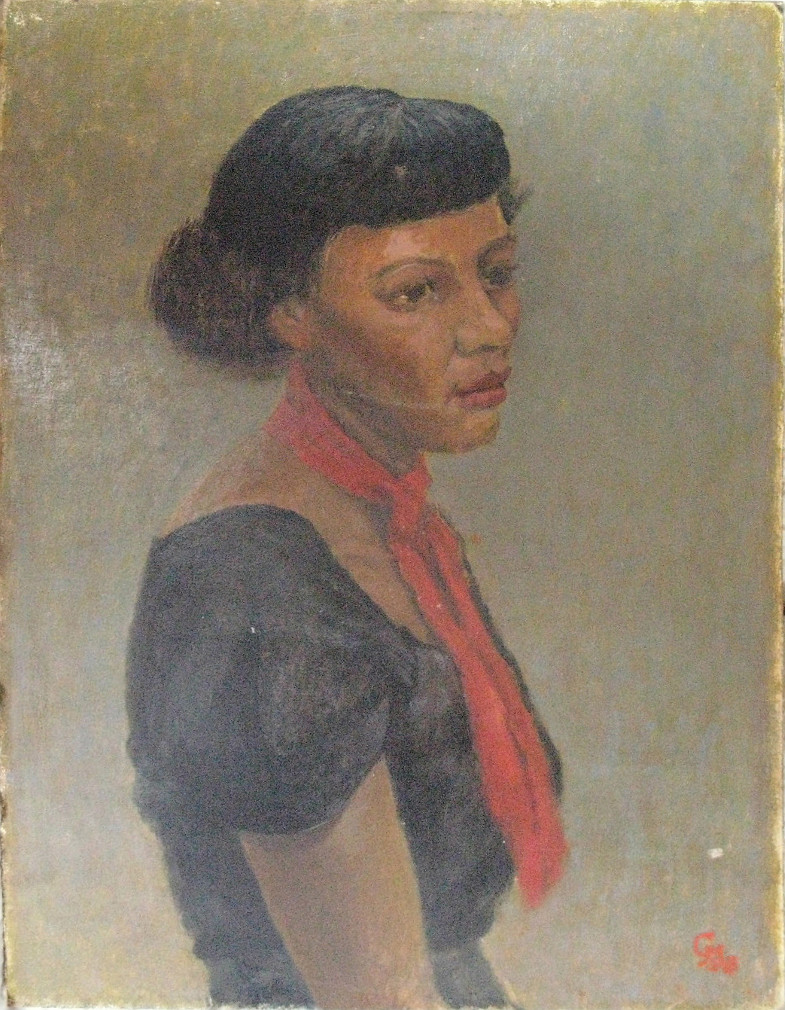
unnamed, George Meldrum, 24" x 18", oil on
fiberboard, 1958

George Meldrum monogram

George Meldrum signature

Inscription
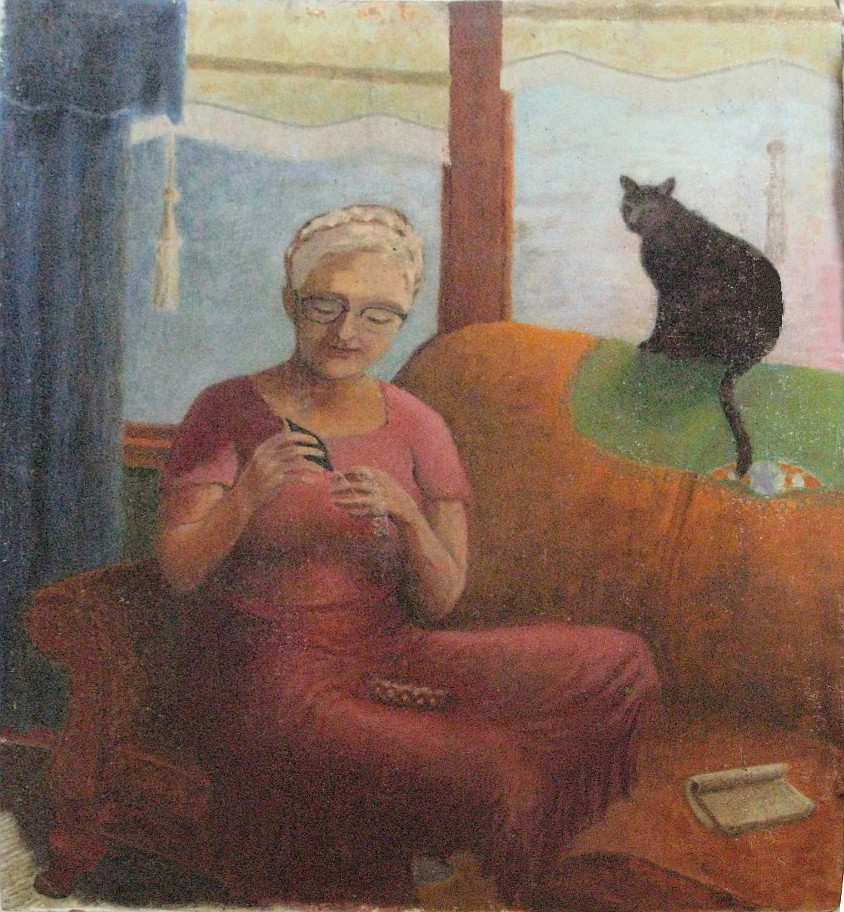
This appears to be a painting worth
saving, so I used the Gimp to do some touch ups and show
what it might look like, if restored. Anything with a cat
in it is worth the effort.
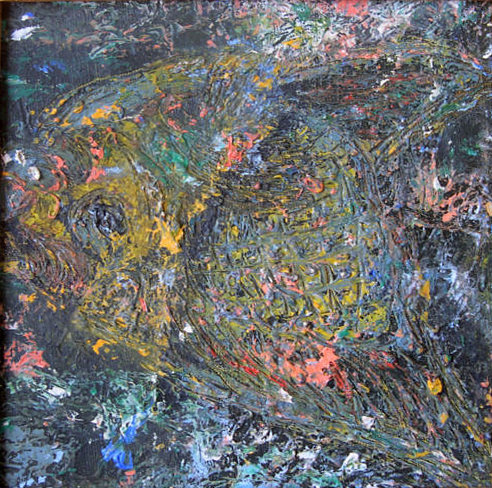
"Marine life #13", W. Gertrude Walker, 5" x 5", oil
on card
This
painting is unsigned but bears a label verso, that has
the artist's name "W. G. Walker" and her address in
Beverly Hills. This label permitted tracking her to two
other addresses, a condo Los Angeles in 1991, and a
retirement home in Palm Desert, CA in 1993.
Unfortunately her birth date was not given in the
on line directory, as is often the case.
There were two women named Gertrude W. Walker in
California Death Records and the Social Social Security
Death Index, both dying on Orange County, CA in 1994.
One of these women had a middle name that would be
unlikely to be used as a first name, so can be
eliminated. The other woman was Gertrude Winifred
Walker, who was born on 4 January 1910 in Uhrichsville,
Ohio, a daughter of Clinton S. and Gertrude White
Walker. Clinton was employed as a "merchant, tailor
shop" in the 1910 census of Uhrichsville, as an
"upholsterer, r r shops" and "tailor, tailor shop" in
the 1920 and 1930 censuses of Columbus, Ohio. Winifred
appeared as both Winifred G. and Gertrude W. in census
records, but was listed only as "Gertrude" in the 1910
census. The true order of her first and middle names, is
not certain, which makes tracing her more challenging.
Winifred Gertrude did not have an occupation in 1930. By
1942 Clinton S. Walker and wife Gertrude had relocated
to Los Angeles, CA, according to voter registration
records. Both were listed as Democrats. Winifred was not
present, but was living with her parents in 1946,
according to voter registration records. Mrs. Gertrude
Walker died in Los Angeles in 1948 and Clinton died
there in 1951. Winifred Gertrude Walker next appears in
records in 1973 and 1975 when she was living in Beverly
Hills, CA. By 1991 she was living in Los Angeles. She
was listed as Gertrude W. Walker in 1973 and as W.
Gertrude in 1975, while living at the same address. No
other information about her life or work as an artist
has been found. Two works by her are known, though the
title of one suggests there were numerous others. The
two known works were signed or labeled verso, but not
signed on front, so there may be works by this artist
missing their backing, that would be difficult to
attribute. There was also a British artist named
Winifred Walker, who could be confused with this artist.
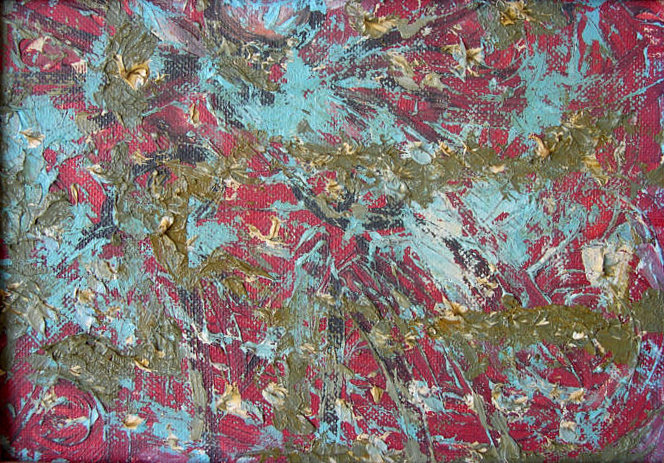
"Trees", W. Gertrude Walker, 5" x 7", oil on card,
1971
W. Gertrude Walker died on 15 December 1994 in Palm
Desert, Riverside, CA.

unnamed, unknown artist, 8" x 10", oil on masonite
This
painting came from the estate of a local woman, Kathryn
Ruka Willis in Bloomington, Illinois in 2011. Her
husband, Edwin Roy Willis also lived in Bloomington and
died there in 1987. He was a professor of zoology at
Illinois State University. It could have belonged to
either person. It is well done and in a striking frame
of some soft wood, perhaps pine. Unfortunately, it is
not signed and attempts to contact family members has
failed.


unnamed, O. B. Dye, 10" x 8", oil on board
I
believe
these
two
small
paintings
to
be
the work of Olive Bagg Dye, based on the signature.
Olive Bagg Dye was born on 19 August 1889 in Lincoln.
She studied with her father, Henry Howard Bagg, at the
Chicago Academy of Fine Arts and at Nebraska Wesleyan
University. Although Lincoln was her main residence, she
was active in Los Angeles during the 1930s. After the
death of her husband, Milton Dye, she settled in Los
Angeles and remained there until her death. Mrs. Dye was
an art teacher had many art students, operating a studio
in Lincoln, Nebraska and Los Angeles. She was one of the
organizers of the Palette Art Club in Lincoln. She
worked as an interior decorator and was a highly skilled
painter of landscapes, western genre and mountain
scenery similar to that of her father's. She also
painted murals. Her work was widely reproduced by the
Murphy Calendar Company in Red Oak, IA. She
exhibited at the Nebraska State Fair, 1930 where she won
an award. A lengthy biography for her appears in the 4
March 1959 edition of the Lincoln Evening Journal and
Nebraska State Journal. Dye is listed in Mallett's Index of
Artists, the American Art Annual (1933), Who's Who in
American Art, Whos who in the South and Southwest
by Larkin (1947), Artists of the West by Dawdy, California Artists
1935 to 1956 by McCall, Dictionary of
Women Artists by Pettys and Davenports Art
Reference and Price Guide.
These paintings are obviously
extremely dirty, and looking at the edges it is easy to
see how bright and striking they would be if cleaned.
They are not varnished, so I am not sure how well they
could be cleaned, though.
Olive Bagg Dye died in
Covina, California on 22 February 1977.

unnamed, O. B. Dye, 10" x 8", oil on board
There is a partial label on the back of one of the
paintings, that might help to date them.

Label, verso

Dye signature

Dye signature

"unnamed" by W. Bartsch, 15" x 18", oil on canvas
This
painting was offered as a "very early work by Wilhelm
Bartsch". I am very dubious about this attribution, for
a couple of reasons. First, the painting is on an
American made canvas and bears a stamp that says "The
Pfleger Pat." with an 1886 date and a Chicago, IL
address. I have found no indication that Wilhelm Bartsch
ever traveled to the U.S. Second, all of the
paintings that I have seen that are attributed to
Bartsch are signed "W. Bartsch" in cursive. There is
some similarity in the "B" in Bartsch on several of
these paintings, in that the bottom of the letter is
open. One painting, dated 1941, bears a very ornate
signature that is unlike any other signature claimed for
Bartsch. What I can say about this painting is that it
is a very old painting, judging by the toning on the
back of the canvas and the age of the stretchers.
Another thing that makes it seem certain that this
painting is by an American artist named W. Bartsch is
that the size of the canvas is indicated on the
stretcher as "15" on one bar and "18" on another bar. I
purchased this painting because I love bleak winter
scenes. My guess would be that this painting dates to
the early part of the 20th century, or a bit later. It
does appear to be in a European style, but there were
numerous Bartsch men of German extraction in the U.S. in
censuses in the early 1900s whose first initial was "W"
who might have been the artist.

Stamp on stretcher. Note the number 18, indicating the stretcher length in inches.
This stamp, or some variation
of it, was apparently used for several decades. I have
seem paintings created in the 1940s that are noted to
have a similar stamp on the stretcher. Most of the
works by Bartsch that I have seen offered for sale
either sold for or were offered in the low thousands
of dollars. I paid $40 for this painting and noted
that it had previously been offered for $100 with not
takers.


"Casa Sondriendo", L. J. Armstrong, 16" x 20", oil, summer 1963
I found this in an antique shop
in Atlanta, IL. The shop owner told me that he found
it in a local auction. The artist added a very
informative set of inscriptions verso, that give the
title and date, along with information about where the
artist sat while painting the work. The artist, Laura
J. Armstrong, also fully signed the work on back. All
that being said, I have found no mention of this
artist. It came in a particularly nice pickled oak
frame. There are only three women with this name in
the Social Security Death Index. Only one lived in
Florida. She was born on 11 April 1898 and died on 30
August 1994 in Saint Cloud, Osceola County which is
some distance from Ft. Lauderdale where this painting
was done. Her Social Security number was issued in
Missouri.



unnamed, Hottingh? Nottingh?, 18" x 24", oil? acrylic?
Found this at the local thrift
shop. It appears to have been painted with a knife. I
think it is an oil, but it could be acrylic. The
signature is very close to being readable, but I just
can't make it out. Very colorful. I originally bought
it for the frame, but soon began to really like it,
especially once I saw it in good light. It would be
shame to not identify this artist.

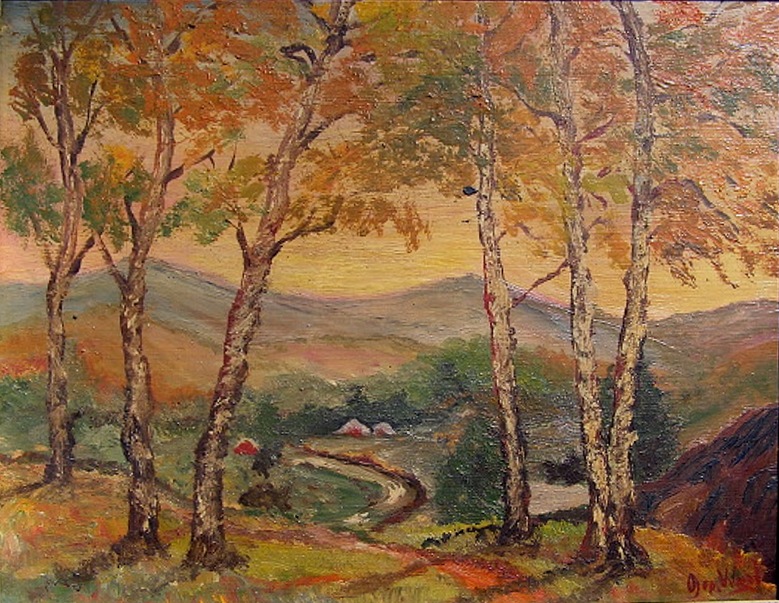
unnamed by Geo. Wood, 8" x 10", oil on card, #612
This is one of a pair of
paintings by George Wood that were offered by an ebay
seller in Palisades, New York in April 2011. Both
paintings were numbered verso, #612 and #615. This
leads me to believe that this was more than a casual
artist. The other painting was better done, in my
opinion, but was sold before I spotted them. The other
painting was signed "G. Wood", and mine is signed
"Geo. Wood".

unnamed, G. Wood, #615
The seller estimated these
paintings to be circa 1920, but I think they may
be a bit earlier. Both paintings also had the
letters "E D" in pencil verso. I suspect that
these paintings are the work of George Albert Wood
1845-1910, but I am still researching this
possibility.



unnamed, unknown, 10" x 12", oil
I found this is a local thrift
shop and paid only about $5 for it. It was well framed
by a local frame shop that was in business in the
1950s to 1980s. There is what appears to be signature
in the lower right corner, but I cannot make it out.
It is painted on a commercial canvas board that has
been cut down to this size. The canvas board does not
have a manufacturer's mark on it. The framer, Chester
Wonderlin, advertised himself as the largest framer
east of the Mississippi River, a tongue in cheek claim
based on his 300 pounds plus weight. Probably won't
be able to find out more about this piece. I
like these kind of Fauvist, soft landscapes, which
seem to have been in fashion in the 1940s and 1950s. I
have several that can be traced to various parts of
the country, so assume that there was some movement
associated with this style.


unnamed, Williams, 14" x 11.5", oil
Don't really expect to find out
anything about this painting, but it is a bit unusual.
It is and odd size, painted on a home made canvas
glued on a thick plywood board, which may be a clue
for those who know this artist. The signature is a bit
unique, too, composed of upper and lower case letters.
I like the simplicity of this piece and the colors. It
was purchased on ebay in March 2011 from the Goodwill
Industries of Middle Tennessee.

verso

Signature
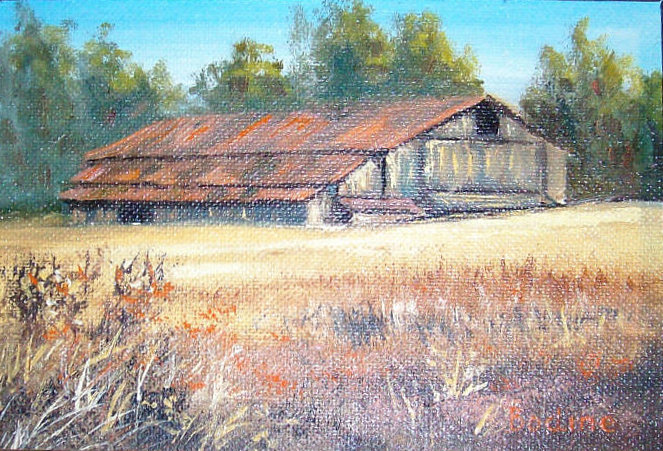
"Methow Valley Barn", Helen Bodine, 5" x 7", oil
Kind of a mystery artist. I
have found a couple of other paintings by this artist,
both with Washington state roots. Methow Valley is in
Okanogan County, Washington, so my guess would be that
Bodine was a Washington State artist. The other two
paintings I have seen were mountain scenes and Methow
Valley is in a mountainous region. One auction for
another painting described Bodine as an artist who
died in 1958, but I have not been able to confirm
this.

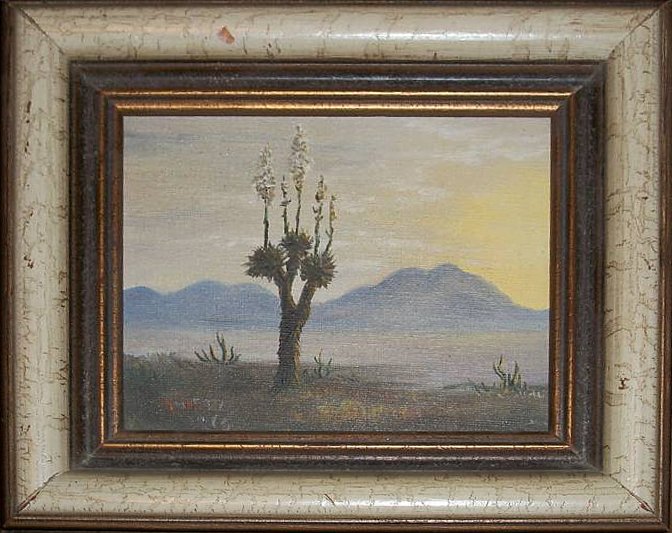
Just a nice little painting
of a yucca tree. The artist's management of light
and shadow is better than this image shows. It is
not signed and is painted on a small stretched
canvas that is stapled into the very attractive
frame with brads. I bought it knowing that it would
be a mystery painting, but really like it.

unnamed,Fizesil, 10" x 8", oil
I found this on ebay and paid
very little for it. I think it is a fairly well done
portrait, at least the face. The signature is
awkwardly signed, with the last letter of the name
wrapped around the side of the canvas. The name is so
odd the I doubted that I was reading it correctly
until I found three other mentions of the artist's
work, two figurative works of females, one identified
as a "gypsy". The subject of the third painting, from
a Swedish auction, was unidentified. The style of the
painting makes me think this was painted in the 1970s,
perhaps. The frame is a fairly interesting 1970s or
1980s vintage frame, made in Mexico. The seller was
located in Woodland Hills, California. I'll get a
better image of the painting and signature when time
permits.

"A Fall Spectacular", J. Hutson, 2.5" x 3.5", acrylic, 2010
I am generally not a fan of
miniature or ACEO-type paintings, but this one was
very nicely framed and matted, and as a package, quite
striking. It is signed, titled and dated, verso. It
was very inexpensive, as well, so hard to pass up. I
like Fall scenes and this one is very well done, with
lots of detail and nice use of light and shadow.
Unfortunately, I cannot find out anything about the
artist. Any help would be appreciated. I purchased
this from a dealer in Ipswich, Massachusetts, so this
may be a New England artist.

Framed painting

Inscription, verso

unnamed, Melodie Song, 11" x 14", oil, 1973
This was an
ebay find, purchased from a seller in Monrovia,
California. I believe it is by a California artist, as
the frame is a standard style that I have seen on
several California paintings from this period. Other
than that, there are no clues as to the history of
this artist. The name almost seems to be made up. I
have not been able to find any mention of this artist,
though I did find mentions of an alternate spelling,
Melody Song, though nothing for an artist. The Song
surname appears to be either Chinese or Korean. The
work seems to be more complex than that of an amateur,
so I would suspect that there are other works out
there by this artist. This is possibly Monument
Valley, if an actual place.

Signature from painting

unnamed, Montford, 4" x 5", oil
I purchased these two small
paintings on ebay from a seller in London, Ontario,
Canada. The bridge scene is not signed, but there is a
notation verso that says "R. D. Montford". This
may or may not have been added by the artist. The
paintings are in identical frames and well presented.

These are obviously fairly
contemporary paintings, probably painted in the past
20-30 years. The artist may be Canadian or British.
There were, and are, several active artists named
Montford, but I could find no examples of works or
signatures that were similar to these works. I would
appreciate hearing from anyone who can identify this
artist.

Montford signature

unnamed, unknown, 7" x 10", watercolor
I purchased this from a seller
who believed it to be done by a French artist. He also
believed that he had seen or owned other work by this
artist in the past, but could not remember the
artist's name. Unfortunately, it is so lightly signed
in pencil in the lower right corner that neither he
nor I could make out the signature. Just a nice little
watercolor.

unnamed, H. Harvey,4" x 6", oil
Paintings by H. Harvey are
fairly common and were produced in apparently large
quantities by this artist for the Woodstock Workshop,
as shown by the label on the back of this painting,
and several other examples of the artist's work that I
have seen. Several artists created small paintings for
this art colony, some later well known artists, and
others, like Harvey, obscure. Much of this artist's
work appears to be very crude, especially the small
works. Some of the artist's larger works, and a few of
his small works, are more well done, though I have
seen only three or four examples of these larger works
and all were in the 8" x 10" to 12" x 16" size range.
It is difficult to date this artist's work as the
Woodstock Workshop seems to have been active from the
1930s through the 1950s, but my guess is that these
works were produced in the later years of this range.

Label, verso
Paintings by this artist have been
attributed to Harold LeRoy Harvey 1899-1971. I am not
comfortable with this attribution at this time, I
actually do not believe that this attribution to be
correct, but list information for this artist as I
found no comprehensive biography for him. Harold
LeRoy Harvey was born 7 July 1899 in Baltimore,
Maryland, a son of Harry D. and Mary C. Harvey. Harry
D. Harvey was employed as "Secty. R. W. Supply Co.
Maryland, USA." in Baltimore in 1900 and as a
"manufacturer, chemical" in the 1910 Baltimore census.
Harold LeRoy Harvey completed his WWI draft
registration, giving his occupation as "commercial
surveyor" and employer as "United States government".
Harold was still living at home in 1920, and gave his
occupation as "Art Student, Oil Painting". Harry D.
Harvey was employed as a "manufacturer, Iron and
Steel" in 1920. Harold applied for a passport in 1921
indicating his desire to travel to France, Greece,
England, Spain, Italy, and Switzerland for the purpose
of "Study of Art". This application contains a
document signed by his parents attesting to his date
of birth and place of birth as 606 North Carrollton
Avenue, Baltimore, Maryland. Harold traveled to Europe
in 1922 and left Cherbourg, France when he came home.
Harold applied for a passport again in 1923, noting
that he had last applied for a passport in 1921. He
indicated his intent to travel to Portugal, Gibraltar,
Spain, Monaco, France, Italy, Finland, Germany,
Holland, Belgium, Greece, Constantinople, Palestine,
Egypt, British Isles, Switzerland, Assyria, Damascus,
Aleppo, and other places which were obscured by
binding of the pages. His objective as noted as "Study
and Travel". He appears on several passenger lists in
the 1920s. He had adopted a very stylized signature
which he used on his passport applications. I do not
know if he continued to use this signature. His
applications also included a photo, though the 1921
application photo was very poor.


Passport photo and
signature
Harvey is listed in Davenport’s,
Who’s Who in
American Art, Who Was Who in American Art,
Fieldings, etc. He was an illustrator, painter,
photographer and designer, though perhaps best known
as a photographer. According to Falk, Harvey studied
at the Pennsylvania Academy of Fine Art where he was a
pupil of McCarter, Despujols, Baudouin, Turner, and M.
Denis. I have read that he was an assistant to Man Ray
from 1920-1923, but have not been able to confirm
this. If true, this likely took place in Paris,
as Ray relocated there in 1921. This claim does not
really fit well with the extensive travel plans noted
in Harvey's passport applications, so I expect the
truth is somewhere in between. I have also read that
he was interested in experimental printing, and
developed "777" liquid film developer and several
toners. He later founded the Harvey Chemical Company
in New Jersey, but his Social Security number was
issued in Maryland in the early 1950s.

unnamed, unknown, 16" x 20", oil
This was an ebay find. I can't
decide if it is amateurish or if it is sophisticated
in its simplicity. Maybe I was simple for buying it. I
really like the colors and all of the action in the
piece, though. I think it is just a fun piece and it
was very inexpensive. I guess I'll call it a good buy,
because I think the entertainment value will repay the
small price I paid for it. Unfortunately, it is not
signed, so I bought it knowing that I will probably
never know anything about it. I purchased it in
October 2010 from a seller in Vermillion, Ohio, but I
have also found that this seller has a Wilton,
Connecticut address. Maybe an importer, though this is
not a new piece. The seller is also connected to an
art and picture frame restoration and interior
decorating business, I discovered.

unnamed, H. Larimore, 12" x 16", oil
I purchased three paintings by
this artist out of about a dozen that the Tuscon
seller listed on ebay. Some of the paintings that were
sold before I discovered these auctions were quite
striking. All three of mine are painted on Grumbacher
Plyex Canvas Board. The seller found them at a church
based thrift shop. I am undecided about the skill
level of this artist. The paintings seem deceptively
simple in style at first glance, but are well composed
and complex when examined more closely.

unnamed, H. Larimore, 16" x 12", oil
Both the seller and I
suspect that the paintings came from the estate of
a Tuscon citizen. The only Larimore with the first
initial "H." who died in Arizona was, according to
the Social Security Death Index, Harry J.
Larimore. Harry J. Larimore was born in
Plainville, Illinois on 13 January 1919, a son of
Harry W. and Nellie M. Larimore. Harry W. Larimore
was working as a farmer in Pike County, Illinois
in 1920 and in Hand County, South Dakota in 1930.
Harry Larimore was living in Seligman, Arizona at
the time of his death. He died on 31 March 2004 at
the Veterans Affairs Medical Center in Prescott,
Arizona. There is a very brief obituary for Harry
in a Prescott newspaper.

unnamed, H. Larimore, 12" x 16", oil
I have been able to find out
very little about Harry J. Larimore, so far. The
search continues.....

"Connecticut March" (?), J. Nichols, 8" x 10", oil, 1950
This painting was purchased
from a seller in New York City who said "this is a
antique oil painting i just acquired at a high end
thrift in new york city just came out of a penthouse
on central park west". I'll get a better picture of if
by and by. What is apparently the title and date are
lightly penciled on the dust cover where it is glued
to the frame. I am not certain the second word in the
title is "March", but the first two letters do appear
to be "Ma". There are several Nichols artists listed
in Davenport's Art Reference and Price Guide who had
the first initial "J", and there were probably many
more who were never listed. I guess I would say this
is done in the Fauvist style, and the seller estimated
it to be a 1940s vintage painting. I doubt that this
seller has the knowledge to
make this judgment and also they have not been
particularly truthful with me and other customers in
the past, so the seller's statement is not that
credible. I do really like the painting, though,
especially the colors, depth and style of it. I also
like that it is thinly painted, except for some
heavier work in the clouds. It did come in a vintage
frame and it is obvious it had not been out of the
frame for many years. It seems unlikely that I will be
able to discover the identity of this artist.


unnamed, Clute, 16" x 20", oil
This painting was purchased at
an auction in Allentown, PA. There were at least three
listed artists named Clute who were active in New York
City, which is not far away. One died in 1914, long
before this painting was created. This painting
probably dates from the 1940s. There may have been
other artists with the same surname, so it is by no
means certain that one of the two remaining artists
created this painting. The bridge in the painting, if
it is based on an existing bridge, may be a clue as to
the identity of the artist. I suspect that the bridge
is in either New York or Pennsylvania. I would
appreciate hearing from anyone who recognizes it.

Signature
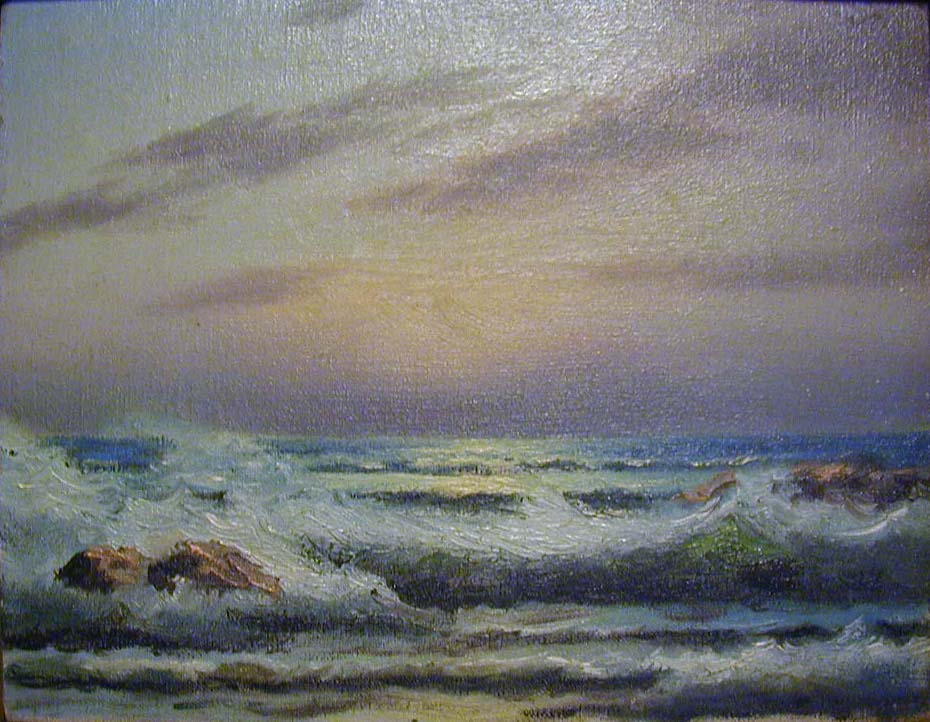
unnamed, Yaffe, 7" x 9", oil
This was an ebay find, which I
purchased because I liked the painting and the frame
it is in. The seller represented it as the work of
either Edith or Herman Yaffee. I was pretty sure it
was by neither of these artists since it was signed
twice as "Yaffe", once on the back of the canvas and
once on the back of the frame. When pressed the seller
said it was definitely the work of Herman because it
was in his style and in the type of frame that he
used. When I asked where the seller had seen Yaffee's
work before he replied that he had seen them on
www.AskArt.com. No works for Yaffee are shown on
AskArt's web site, and when I sent an email to AskArt,
they said that they had no images of works by this
artist. Enough said. The seller was located in
Morrisville, PA.
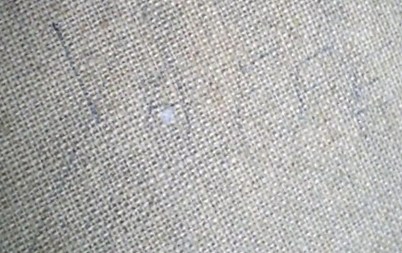
Yaffe signature on
back of canvas
There quite a few artists named
Yaffee or Yaffe, so I am not optimistic about finding
out more about this artist. Especially since this
piece is pushing 100 years old. It is a neat painting,
in a neat frame, and it gives me the opportunity to
tell the sordid story of Herman and Edith Widing
Yaffee, who were man and wife. Sort of.
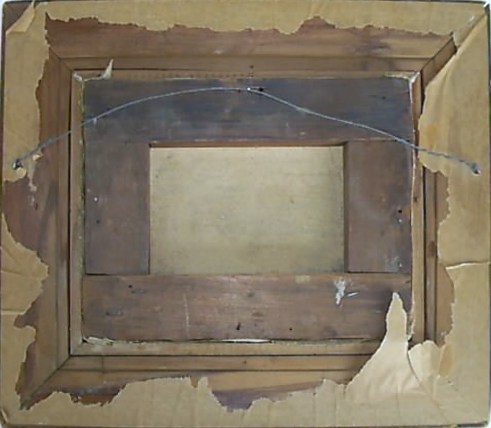
Edith Louise Widing was born on
Helsingfors, Finland on 16 January 1895, probably the
daughter of Rudolph and Elvira K. Widing. They arrived
in Boston on 19 May 1910 on the ship Saxonia from
Sweden. Rudolph's occupation was listed as
lithographer. Ivar Widing, probably Edith's brother,
arrived from Sweden on the Saxonia on 21 April 1905.
The Widing family was living in Boston, MA in 1914. At
the same address were Ivar Widing, illustrator, of
Munro and Widing, and Rudolph Widing, lithographer.
All three were still at the same address in 1915 and
1916. Edith was not listed in the Widing home after
1916, probably because she married Herman Albert
Yaffee. (in progress)

Signature on back of frame

"Cloud Chase", ? Johnson, 15" x 17", serigraph from photograph(s), Artist's Proof
Please excuse the reflection of
my arms and camera in this one. This print is
expensively framed, and I do not want to take it apart
to get a better image. It is a pretty striking piece,
on very expensive paper, with what appears to be gold
foil edging. I am not normally a print person, but
this one is so well presented that I could not abandon
it to it's fate at the Habitat for Humanity store in
Champaign, Illinois where I found it hanging. I can't
make out the artist's first initial. It could be an
"A" or a "C", or maybe even a "G". I am guessing that
it is a serigraph created from a photograph or
superimposed photographs. Prints are really not my
thing, so this is a WAG. I guess you could say that
the whole paper is the image, since it is mounted on a
background with the watermark prominent in the lower
right corner. This would make the dimensions of the
piece 4-6" bigger than given above. It is an artist's
proof for what that is worth. No idea who the artist
is. This could be the work of a student at the
University of Illinois, as the store where I purchased
it is only a couple of blocks from the campus. Not too
many students could afford this presentation, IMHO.
Any help in identifying this artist would be
appreciated.
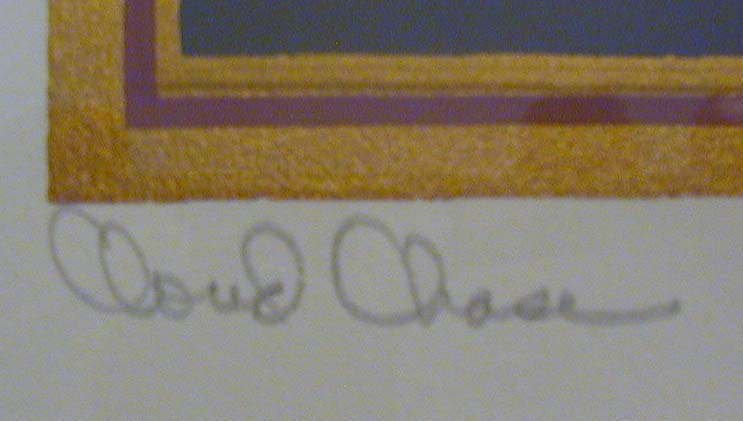


Title, proof mark, signature
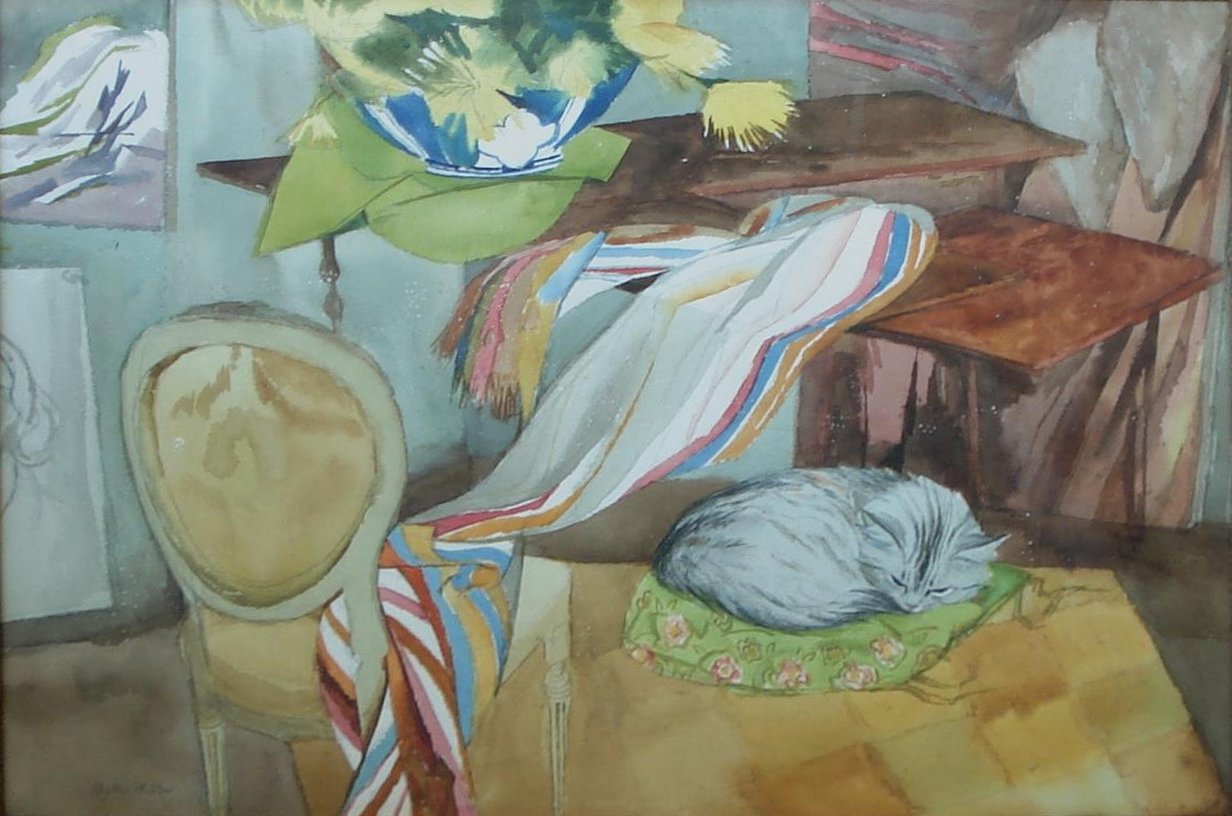
unnamed, Phyllis Miller, 22" x 30", gouache
I originally had this on my "Other Artists" page, as I was confident that I would be able to fairly quickly identify this artist. Oops! My preliminary research turned up three artists by this name who were active in the period, 1970-2000, when I thought the painting was done, even though the frame appears to be much older, perhaps dating to the 1950s. I quickly eliminated two of the Phyllis Millers, one deceased of Hendersonville, NC (she signed her works Rueggeberg Miller according to her family) and one very much living of Los Angeles, CA. The third artist I eliminated after viewing her work and signature. A little more digging disclosed several other artists by this name, one a Professor Emeritus at the University of Houston. So the search continues.

Framed painting
Here are the clues that I
currently have about this painting. The seller of the
painting was located in Monrovia, CA. The seller had
had two other watercolors by this artist, one of a cat
and one of a fox. This leads me to believe that this
was a local (Los Angeles County) artist. The artist
seems to have been a serious amateur or trained
artist. There are pencil marks visible beneath the
paint, so the work was apparently carefully planned
and executed.


unnamed, F. Money, 12" x 9", oil
This is an oil on canvas. The
seller dated it to the 1950s. There was a French
artist named Raoul Billon (1882-1956), who painted
under the name Fred Money. Don't ask. I don' know why.
There are some similarities to the signature on this
painting to Fred Money's signature, but some
dissimilarities, too. I do not think this is the work
of Fred Money, AKA Raoul Billon, but thought I'd
mention it.... I found several of his works on the
Internet, and his style is not similar. Nothing in the
painting to give clue as to the locale, just two kids
flying kites. I like it because I only paid $5 for it,
and also because it is interesting. I find myself
straining to make out the faces of the children, but
know I never will be able to.
UPDATE: I was contacted by a lady who has two
paintings similar in style, color palette, subject,
and signature to my painting. They were purchased
about 1970 by lady's grandmother in Texas. She was
told by the seller that the performer Carol Burnett
was a collector of this artist's work. One is signed
"Fred Money" and the other "F. Money". Unfortunately,
I also found several images of paintings that are
proved to be by the French artist. The style and
signature of these works are very different from my
work and the two similar works. I suppose that it is
possible that the French artist's style and signature
changed over time, but think that this is a stretch. I
did find a fourth work very similar in style and
signature to my painting, and the other two paintings,
that was offered in an online American auction as the
work of the French artist, but I am not convinced that
this attribution is correct. This remains a mystery,
in my opinion.
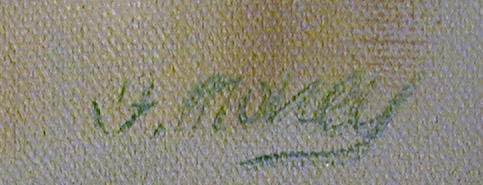
Signature

unnamed, unknown, 10" x 8", oil
This small painting hung in a
local thrift shop for several weeks, maybe months. I
paid only a couple of dollars for it, and since it
came in a decent, common sized frame, I don't regret
it. It is rather oddly colored and though signed, the
signature is largely illegible. I can only make out
the first three letters of the artist's name, "B - r -
u". It is painted on an "Anco Bilt" canvas,
manufactured in Glendale, NY. I think that later these
canvases were manufactured in Taiwan. I have no other
information on this painting. It may be one of the
thousands of paintings commercially produced for
hotels, etc., in the last half of the twentieth
century.

Canvas maker's stamp
The "ANCO BILT"
stamp appears several times on the back of this
painting.

Numbers on back of canvas
There are a couple of
numbers on the back of the canvas, one stamped and one
in black marker, which may be inventory numbers. This
strengthens my suspicion that this painting was
commercially generated and once hung in a hotel,
motel, etc. It may be by an American artist, judging
by the age and origin of the canvas, I have several of
these small commercial oils, and some are quite
attractive. I am guessing that generations of
frustrated, well trained artists, made extra cash
cranking out these types of paintings, until much of
this work went to other countries like Mexico and
Taiwan, where they could be purchased in bulk for
pennies, as opposed to a few dollars in the U.S. I am
not sure that this happened, but is seems logical from
the information I have seen.

Signature from this
painting
I am now seeing machine
generated oils that can be cranked out like ten
dollar watches, many identical paintings. I was
quite amazed when I found a whole stack of such
paintings at a local used furniture store. I have to
wonder if the better done of these small American
painted commercial paintings might not become
collectibles, as it seems that Paint by Numbers
paintings are becoming? Time will tell...

unnamed, unknown, 1 7/8" x 5 7/8", monotype, 1/1, 1991
I found these two small
monotypes in a local pawn shop. They are beautifully
framed and matted. They have the framing label of a
local framing shop, that is no longer in business. I
took them to a framer who sometimes does some work for
me, and coincidentally it turns out that he worked for
the same framer at this time, but could not tell me
anything about them. They are quite striking.

unnamed, unknown, 1 7/8" x 5 7/8", monotype, 1/1, 1991
Both are signed and numbered
1/1 below the print, but I cannot read the signatures.
The first initial appears to be a "D".

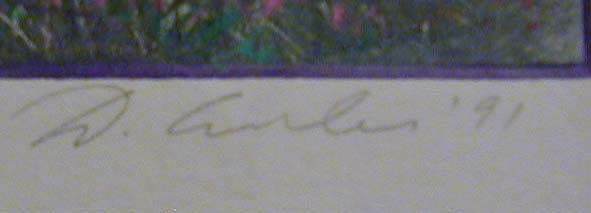

unnamed, Jewel, 9" x 12", oil, 1952
This is an ebay find, purchased
from a dealer in Los Angeles, CA. The seller
speculated that it might be the work of California
artist Jewel Cooper. Her work pops up on ebay fairly
regularly, but little information about her is
available. All of the other works by her that I have
seen are fully signed "Jewel Cooper" and dated
similarly to the work in my collection. The signature
is very similar to my painting, though, and I am more
and more leaning toward accepting the seller's
attribution. All of the other works I have seen are
from the 1960s and 1970s, so it is very possible that
she changed her signature, at some point, adding her
last name. The other paintings that I have seen are in
a similar, though more sophisticated style, and of
similar subject matter. It is likely that this is one
of her earlier works.
There is very little information
available about Jewel Cooper, so I compiled a
biography for her, though I have not been able to
absolutely confirm that there were not two Jewel
Coopers working as artists in California.
Jewel Ida Kelton Cooper was born on
25 November 1902 in Ridge, Fayette County, AL, a
daughter of Lytle Alexander and Ellen Janette Bynum
Kelton. Lytle Kelton was working as a coal miner in
1910. Jewel married Ottis Lee Cooper on 6 October
1951. Ottis was also born in Alabama and was first
married to Abbie Lee. Cooper is mentioned several
times as State Commander of the American Legion,
living in Red Level, Alabama in the mid and late
1940s. I do not know where Jewel and Ottis were
married. They may have married in Alabama.
I have not been able to locate Ottis and
Jewel as a couple in records prior to 1952 when they
appeared in the voter registration records of Los
Angeles, CA. They were registered
as Democrats, living at 11608 Archwood St. in 1952 and
1954. Jewel is mentioned several times in the
Van Nuys News in the early 1960s in connection with
her work as an artist. She was an art teacher and Art
Chairman of the North Hollywood Women's Club. She held
a one woman show at the Security First National Bank
on Ventura Blvd. in Studio City, CA in 1961. The
newspaper reported that she had won many awards for
her work as a landscape artist. Jewel was the
Recording Secretary of the Valley Art Guild in 1961
and "Otis" Cooper was mentioned as an honorary member
of that organization. I have found no record of where
Jewel received her training as an artist. She is not
mentioned in any art reference work.
Jewel Cooper died on 18 October
1992 in Sun City, CA. Ottis died in Sun City on 1 July
1985. Ottis Cooper was a 2nd Lieutenant in WWI and he
and Jewel are buried in the Riverside National
Cemetery in Riverside, CA.


unnamed, Joseph Sacks, 16" x 12", oil
This was an ebay purchase.
There was a well known artist of the same name, whose
signature is very similar, but I have not been able to
confirm that this painting is by that well known
artist. It could be another artist of the same name. I
just liked the colors and style of this painting. The
seller said that the painting came from the San
Francisco area and the well known Joseph Sacks lived
in California at some point in Pasadena, Los Angeles,
and Altadena. I have seen one reference that places
him in San Francisco. I am including a biography of
the well known Joseph Sacks below.
Joseph Sacks was born on 1
September 1887 in Shavli, Russia, a son of Isaac and
Ida Sacks, Russian Jewish immigrants. Isaac came to
the US in 1888 and was joined by his wife and son in
1891. Isaac worked as a peddler in 1900 and 1910, in
Philadelphia. Joseph's birth month and year are given
as July 1886 in the 1900 census but in 1910, his age
was given as 22 which fits, as the date of the census
was 21 April 1910. Joseph's occupation in 1910 was
"artist, studio". Sacks declared his intent to become
a U.S. Citizen on 4 June 1909, while residing at 401
Dallas Street, San Antonio, Texas. His occupation was
given as "artist" and his description as 5' 4" tall,
120 lbs., brown hair, and blue eyes. It was noted the
he arrived in New York City on the ship Arizona on 3
August 1892 from Liverpool, England. On page two of
his petition for naturalization dated 22 May 1914, he
was residing at the same address as that in his WWI
draft registration. His father, Isaac, and a neighbor,
Louis Miller, witnessed his petition. He was
granted citizenship on 15 September 1914. Sack's WWI
draft registration gives his birth date and place,
marital status as single, and his occupation as
"artist painter", employed by "Kimsey 1026 Chesnut
Street", Philadelphia. The registration also contains
a very nice example of his signature, as do his
declaration of intent and petition for naturalization.
I was not able to locate the Sacks family in the
1920 census, but I did find them in Philadelphia in
the 1930 census. Isaac was deceased and Ida was the
head of the household. Ida owned the home, which was
valued at $17,000, a lot of money for the time. Of her
four children living at home, three were employed in
the tailoring business, which may indicate that Isaac
was a tailor. Joseph was employed as an "artist,
portrait shop". I next find Joseph in records in his
WWII draft registration. He was living in
Philadelphia, and gave his contact as Ida Sachs. I
don't know if this was his mother or wife of the same
name. They were living at the same address, though. He
was employed as "artist, portrait painter".
Sacks attended the Pennsylvania
Academy of Fine Arts and was supposed to be a student
of Thomas Pollock Anshutz, William Sergeant Kendall,
and William Merritt Chase. Sacks was a member of the
Philadelphia Sketch Club and the Philadelphia Art
Alliance. He also studied in Europe for several years.
He lived in California in the 1930s. He is mentioned
in Who Was
Who in American Art by Falk, Artists of the
American West by Dawdy, Mallett's Index of Artists,
Dictionary
of American Painters, Sculptors, and Engravers
by Fielding, and Davenport's Art Reference and Price
Guide.
Sachs died in May 1973 in
Philadelphia.


Signature from estate painting
The image of the first
signature above is from my painting. The next image is
of Sacks signature from a painting the was signed
lower left, like mine, and was stamped verso with the
estate stamp from Sacks' estate. They are very
similar. I have seen several other examples of his
signature that are also very similar and a few
paintings on the same size canvas. I'll get a better
image of the signature from my painting, when time
permits.

unnamed, unknown, 12" x 18", gouache
I have had this painting for
quite some time, but only recently put it back
together after taking it apart for cleaning. There is
a framer's label on the back of the painting for
Robert Richard Toth's gallery and framing services. It
is not signed, but I felt certain it was his work as
it is very similar to a couple of paintings from his
archive of works from private collections on his web site.
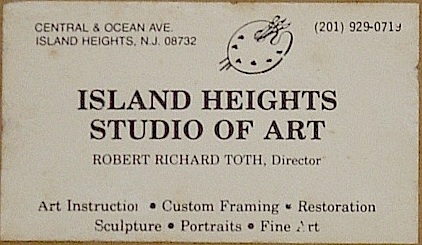
Business card, verso
I was eventually able to
contact Mr.Toth, and he told me that this is not his
work, but probably something that he framed for
someone. He could not tell me anything else about the
work. Since it is not signed, I will probably not be
able to find out any more about it. It is very well
done, obviously the work of a talented artist, and I
like it very much.

Toth framed painting

unnamed, E. P. Becher, 12" x 16", oil
This was an ebay find,
purchased from a seller in Nottingham, England. The
seller estimated it to be a 1930s or 1940s painting.
It is not signed on the front, but is signed verso, E.
P. Becher, which may or may not be the artist. There
is a framer's label that reads: "W. F. Gadsby Ltd,
Thrale Galleries (late Humphreys) 326-328 Streatham
High Road, S.W.16, London". This should help to date
the painting, if anyone out there is familiar with
this gallery. W. F. Gadsby Ltd. still exists, and I
have sent them an inquiry about this label. The seller
described the style as "vintage abstract
impressionist" which doesn't fit with the seller's age
estimate, since this was a 1950s movement. I'd class
it as more impressionistic. I think it evokes the same
feeling as one of Monet's haystack paintings. I'll get
a picture without the glare in the center of the
painting, when time permits.


unnamed, Clatworthy, 8" x 10", unknown media
I
purchased this from a dealer in Burbank, California. I
am not sure if it is an oil or an acrylic. It is very
well done, but I can find out nothing about the artist,
despite the rather unique signature. There have been a
couple of prominent artists by this name, but I am
pretty sure that this is not their work. Any help on
identifying this artist would be appreciated.


unnamed, unknown, 9.5" x 13.5", oil
I found this painting at a
local thrift shop. It appears to be a scene at the
Wailing Wall. It was very well framed in a modern
metal frame and archivally matted, and seems well
painted, but in a primitive style. It is signed in
Hebrew in the lower right, but I have not been able to
translate it using what on line resources I have been
able to find. I would appreciate if someone could
translate the signature for me. I removed the painting
from its frame to examine the back, but there is,
unfortunately, nothing written there, so these are all
the clues we get. I looked at this painting for
several weeks as it migrated from a place on the wall
beside the checkout register, to less glorious places,
and finally to an odds and ends painting pile. I
always liked the colors and style, but kept putting
off buying it, until "next time". I finally decided
that I couldn't live without it, so here we are.

Signature?

unnamed, Mimmoy, 24" x 30", oil
I found this at a local thrift
shop for $18. It appears to be signed "Mimmoy". I have
been able to find out nothing about this artist. It
appears to be coastal scene, judging by the fact that
this seems to be painted at low tide. It could be a
Maine scene. It is painted on a Grumbacher 24 canvas,
and has kind of a 1950s or 1960s feel to me. Just a
guess. Any help on this one would be appreciated.


"The Sleepless Village", Catallo, 16" x 20", acrylic, 2001
I found this one on ebay from a
seller in Rockport, MA. I am still researching this
artist. The seller read the name as "Cataldo", but I
think it is Catallo. What do you think?


"Bird in the woods", F. A. Bixier, 9" x 15", oil
An ebay find. These two
paintings were not on stretchers, and were part of a
lot of 13 wildlife paintings by the same artist. They
are pleasant, pretty well done, and were cheap. I
really liked the squirrel painting, and thought this
bird painting was the second best of the lot. A quick
Internet search revealed nothing about this artist.
Research in progress.....

"Squirrel in the branches", F. A. Bixler, 9" x 15", oil
These paintings are old
enough that the canvas they are painted on have
some age toning, which cannot be seen in the
paintings, themselves. They are just pleasant
little paintings. The seller was located in
Bridgeport, CT.


Ysobel, unknown, 20" x 16", oil
I purchased this painting on
ebay for a small sum from a seller in Southgate,
Michigan. I like portraits, though many folks don't. I
did not expect to find out much about it, as it is not
signed. A little research, however, revealed that the
name Ysobel is very rare. Since this painting is
dated 1931, I thought I'd take a stab at finding
something out about the subject. There
were only 16 men and women by this name in the 1930 US
census, and lo and behold one of the women, Ysobel
Crue Lopez, lived in Detroit, about 21 minutes from
Southgate. Possibly just a coincidence, but I am
including the information about her and the main
members of the household she lived in, in case this
rings a bell with someone who may see this web site.
Ysobel Crue Lopez was born about
1901 in Mexico, of Mexican parents and emigrated to
the US about 1915. She married Elis Lopez about 1919
and their first child, Beatrice, was born in Michigan
about 1920. Elis was an inspector in an automobile
factory. Ysobel's father, Benigno Crue was living with
the Lopez family in 1930. He had no occupation and was
a widower. Elis and Ysobel also had; Pola, Juana,
Luis, Cresensio, and Eline. Unfortunately, I was
unable to locate any of these folks in any other
record.

"TAXCO, GRO.", Sanchez, 14" x 20", watercolor
I found this one at a local
thrift shop for a couple of dollars. It looked like a
sepia toned watercolor, as opposed to a print, and it
was cheap, so I took a chance. It is indeed a sepia
colored watercolor. That is all that I know about it.
Taxco was a popular town for art minded Americans in
the 1950s and maybe 1960s. I have several paintings in
my collection by artists who moved there to live and
pursue their art, or visited to pursue their art. Any
information about this artist would be appreciated.
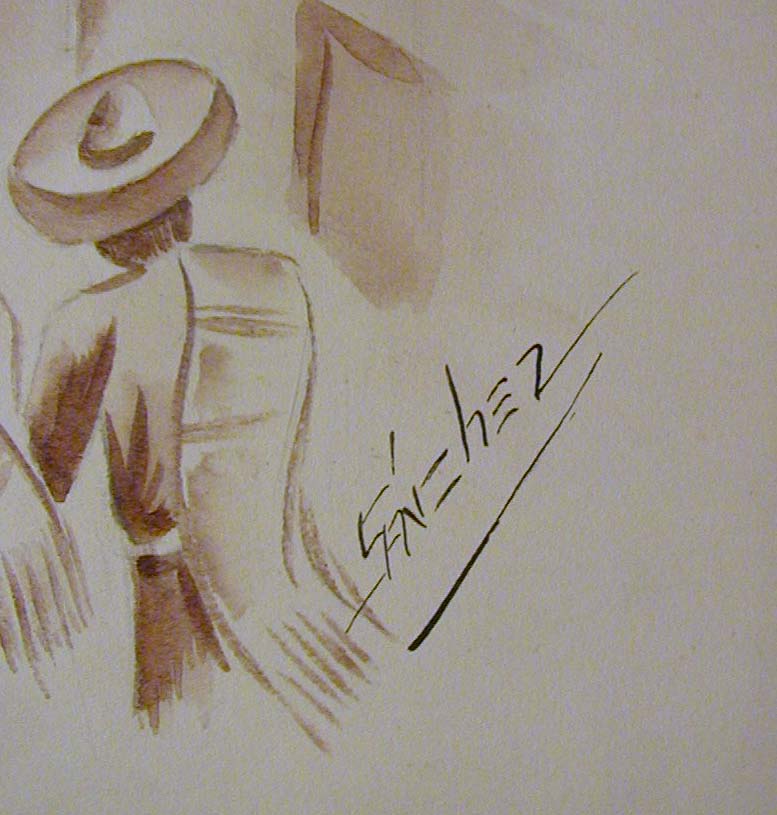
Sanchez signature

unnamed, EK (monogram), 24" x 18", oil
This was an ebay find. It is
signed with monogram "EK" in the lower right. As I
recall, I purchased this from a seller in Tennessee.
It is very dirty, but also varnished, so lots of glare
as seen on the left side of the painting, and it sat
in my difficult painting pile for many months, until I
had time to fuss with getting an acceptable image of
it. In general fairly well done, I think, but the
artist seems to have a problem with painting hands,
which I think are awkwardly done. The artist does a
fair job with light and shadow, though. I don't feel
that there is much of a sense of motion in the
painting, given that the pot is supposed to be
spinning on the potter's wheel. I paid very little for
this one, just tossed out a minimal bid and won it. My
gut says that this may be a work by a student in some
art program, probably at the university level. Not
sure why I feel this way, just an impression. What
appear to be scratches on the painting are actually
glare from the texture of the artist's brush strokes.


unnamed, after Maurice Prendergast, 14.5" x 19.5", watercolor
I found this at a local thrift
shop. It is extremely well framed and sealed, so I
have not taken it apart to look for a signature or
title. No signature is visible on the front of the
painting. This appears to be a loose copy of "May Day,
Central Park", by Maurice Prendergast. It is not an
exact copy, and is not signed where Prendergast's
painting is signed. This may be an homage to
Prendergast by an admiring artist. It was framed by
Beach Arts of Bonita Springs, Florida. The glass was
so dirty that it appeared quite washed out, but I was
surprised at how rich the colors were, once the glass
was cleaned. A pleasant surprise. I looked at it for
several weeks, before deciding to buy it. It is a
painting that grows on you. There is certainly a lot
going on in this painting. I have no real hope to find
out more about it, so just going to enjoy it. I made a
place for it on my wall, even though I have many
other, more sophisticated works looking for a place to
hang.

unnamed, Mary Alice, 20" x 16", oil
The artist signed this painting
simply "Mary Alice". I think that the figure is pretty
well done, and I like the colors. The use of light and
shadow, though understated, is nice, too. It came in
pretty cool frame, as well. Someone, not necessarily
the artist, included a Bible verse using an ink pen on
the back of the dust cover, Galatians 6:9, "And let us
not be weary in well doing, for in due season we shall
reap, if we faint not.". It is hard to to tell how old
this painting is, but probably from the 1970s or
1980s, I'd guess. The seller claimed it came from a
high end estate sale. I suspect that this may be a
piece done by a member of a religious order.
Communities of religious orders often commit extensive
resources to the creation of art, often not religious
based art. This may well be a work by "Sister Mary
Alice".
Any help in identifying his
artist would be appreciated.


"Tartanes A Quai, St. Tropez", T. (or J.) Spisso, 10" x 8", oil, ca 1944
This was an ebay find. The
seller said that his father purchased this painting on
his way back from WWII in 1944. That is all I know
about it. This signature is a bit hard to make out,
but I believe it is Spisso. The person I purchased it
from read it as Sasso. There was an Argentinian artist
named Liberato Spisso, but he was born in 1930 and I
find no evidence that he ever traveled to Europe. Any
help in identifying this artist would be appreciated.
Tartanes were barques, or small ships that were used
on the Mediterranean. I have read that they went out
of use in the late 19th century.

Spisso signature

unnamed, C. M. Agnew, 12" x 10", oil
The only artist that I can find
listed that could possibly be this artist is Clark M.
Agnew, but this is just a guess. Clark Mansfield
Agnew was born in St. Paul, Minnesota on 20 June 1905
a son of William Livingston and Laura Jay Waynick
Agnew. Both his father and brother were employed as
"Advertisers, general practice" in the 1920 census of
Chicago, Illinois. Clark Agnew attended the Art
Institute of Chicago, paying his way by playing the
clarinet in Dixie-land and Chicago style bands. He
married a woman named Gloria about 1929. She ways born
in Hungary. They were living in Manhattan in 1930,
where Clark was employed as an "artist, commercial". He
produced advertising art for several prominent
magazines. Agnew was later a television producer and
wrote a book about television advertising in 1958. Using
Google, I found the following link
that has information about Agnew's life and some
examples of his advertising art. Clark M. Agnew is
listed in Who's Who in American Art, Who Was Who in
American Art, and Davenport's Art Reference and Price
Guide. I was immediately drawn to this painting
because it reminds me of a place where I go hiking.
Clark Mansfield Agnew died on 2 May
1959 in Norwalk, Connecticut. Gloria B. Agnew died on
6 August 1996 in Westport, Connecticut.

Signature

unnamed, Krueger, 10" x 11.75, oil, 1939
This was $9.95 ebay find. The
seller was in Des Plaines, Illinois, but I am not sure
that this is an American artist. It could be a German
immigrant or a souvenir of a trip to Germany. The
signature is rather distinctive, though I don't expect
to find out anything about this artist. I just like
the style of the painting and the colors.

Signature

unnamed, D. Duclair, 11" x 15", watercolor
D. Duclair seems to have been a
fairly prolific Haitian watercolor artist who was
active in the 1950s and 1960s. At least that is how he
has been characterized on various auction web sites
and artprice.com. The value of his work varies wildly
from auction to auction, sometimes selling for tens of
dollars and other times for hundreds of dollars. I
have not had a chance to take this painting apart to
get a good picture of it, and there is a lot of glare
in the photo above, notably around the figures in the
foreground. I was able to use the Gimp to clean up the
glare in the other parts of the photo. I'll get a
decent image of it by and by. Any information on this
artist would be appreciated.


unnamed, unknown, 7" x 6", oil
Another little ebay find. I
like small paintings, because I don't have much free
wall space. So small is among the first things I liked
about this work. Then I liked the colors and motion in
it. And lastly, I liked the $9.99 price, which is what
I paid for it. The signature is close to readable, and
is a good research opportunity. The name looks like
"A. Zosber" or "A. Zesber". It could also be Zesbet or
Zosbet. It came in an interesting frame that makes me
think it is a 1950s, or early 1960s work. Just a
guess. The seller was in Gouldsboro, PA, but this kind
of feels like a California painting to me. Help!


unnamed, unknown, 4" x 6", oil, 1950
This
was an ebay find. It is actually painted on a small,
stretched canvas. I suspect it is a souvenir of a trip
to Europe. For such a small painting, it is nicely
detailed, and I think, very well done. The subject
appears to be a hunter, judging by the shotgun over his
shoulder. His dress probably gives away his nationality,
but I do not know what that might be. The signature is
quite distinctive and appears to be the initials "A L".
It is in what appears to be its original, green painted
frame. I was once a pipe smoker, so appreciate the
beauty of his pipe. I don't expect to find out any more
about this small painting. The seller was located in
Burbank, CA.
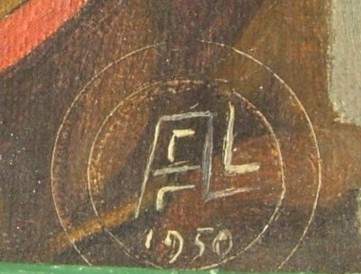

unnamed, Spragg, 12" x 16", oil on board
No idea who this artist is, but
I love this painting, and it is one of my favorites. I
purchased it from a seller in Townsend, MA, who
estimated the board it is painted on to be pre-WWII.
It is a small painting in a really nice vintage frame,
was cheap, and I am a sucker for bleak winter scenes,
especially with a small pop of color like the red in
the woman's shawl.
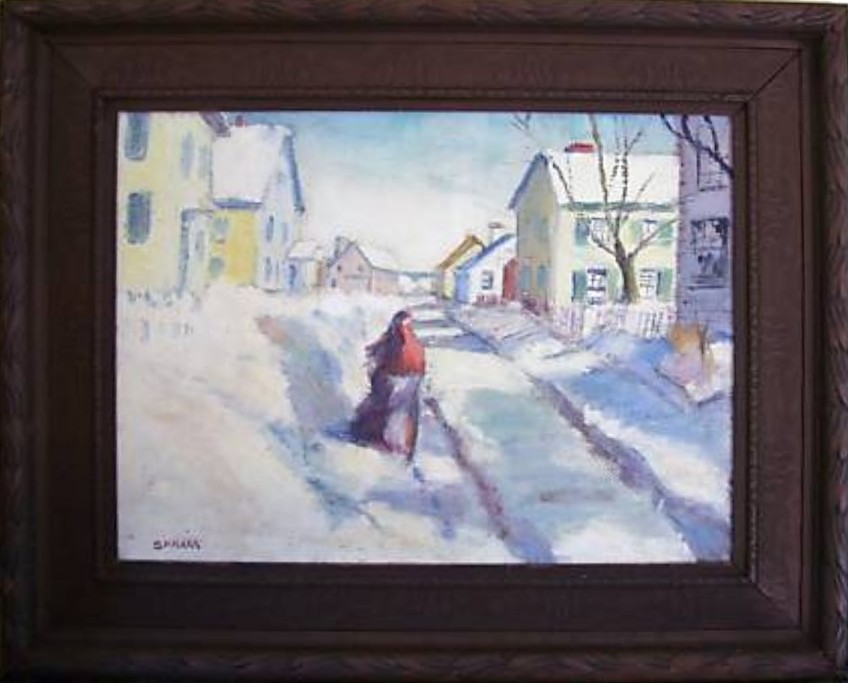
The dark frame really makes this painting pop.
I researched a man named Spragg
who I though might be the artist, but it was a false
lead. What I did learn is the name Spragg is Norwegian
and pronounced the same as the surname "Sprague". Any
help in identifying this artist would be appreciated.
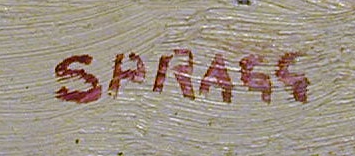

"Snow on Onondaga Road", Peter Shostak, 17" x 29", acrylic, 1977
This painting was sold to the
folks I purchased it from as the work of well known
Canadian artist Peter Shostak. I contacted the artist,
however, and he confirmed that this is not his work.
The painting is signed verso both "P. Shostak" and
"Peter Shostak". The sellers took the painting back to
the people they had purchased it from to ask for a
refund, and they were apparently rudely turned down,
even though I sent them the email from Mr. Shostak,
claiming they had sold it as his work in good faith,
believing it to be a painting by him. The question now
becomes did the original sellers sign the work in an
attempt to pass if off as the work of Canadian artist
Peter Shostak, or were they also duped, or is this
work by another artist also named Peter Shostak? I
like the painting and the cost was very little, so I
decided to keep it and use it as a research
opportunity. The painting depicts the Syracuse Mony
Towers, as they were then known (now the AXA Towers)
as seen from Onondaga Road in winter.
My initial research showed that
there are up to nine men named Peter Shostak now
living in the US. I also found the record of another
Peter I. Shostak 1913-1989 who was born in New
Hampshire, lived in New York state, and died in
Orlando, Florida. His WWII enlistment record shows
that he had four years of college and was working as
an actor at the time of his enlistment. He was the son
of Russian Jewish immigrants John G. and Annie
Shostak. He married Anna Yaroush on 11 October 1964 in
Stratford, CT. There were also several other men by
the same name, who were too old to be the creator of
this painting. I have not been able to find contact
information for the nine living men, but will keep
trying.
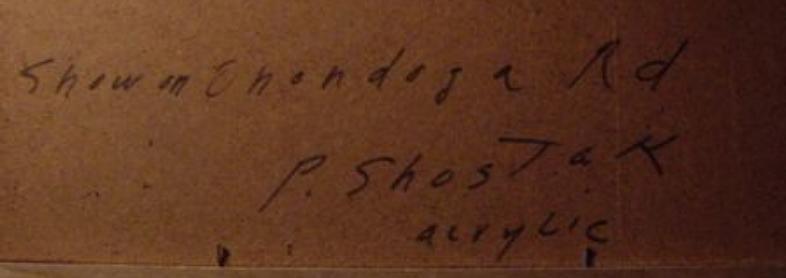
Title verso
The painting is titled verso.
The second seller is from Baldwinsville, NY and the
original sellers live nearby. I tried unsuccessfully
to find an image of the Mony Towers from this
perspective.

Signature verso

unnamed, Esther Meyer (Heyer?), 11" x 14", gouache
I purchased this painting on
ebay from a seller in California, which may indicate
she was a California artist. The seller had a few
paintings by this artist and on some the surname
appeared to be Heyer as opposed to Meyer. I am not
really certain which is correct. The paintings were
all rather well done and in a distinctive style. Three
women named Esther Heyer died in California between
the late 1980s and late 1990s. She may have been one
of these women. There was a prominent California
artist named Esther Meyer (1897-2000), but she appears
to have been a graphic artist working mostly with
engravings and etchings. I have seem a couple of
examples of paintings by her, and they did not greatly
resemble this artist's work, though the subject matter
was very different. This is a pleasant painting,
though, and it appears to be the work of a practiced
artist, so I hope to eventually discover more about
her.


unnamed, M. Considine, 10" x 8", oil on canvas
I
picked this up at a local pawn shop for $15, as I
recall, mostly as a research opportunity. I was never
able to find out anything about this artist, and it may
be one of those sweatshop Mexican paintings. The age is
about right, maybe 1980s. It is a genre painting and I
have seen many done using a similar composition of two
sailing ships in a harbor next to a pier. This one is
maybe a bit better than most of those, I think. Very
colorful an some nice detail in the crowd on the dock.
It actually has pretty good depth and lighting, too, so
not a total waste. Doubt I will ever know more about
this one than I do now.


unnamed, Bale, 3" x 5", watercolor
I found this one at a local
thrift shop and paid very little for it. For such a
small painting, it is very complex and colorful. It
was simply but nicely framed and matted, and I half
expected I would find it was some kind of print when I
removed the cardboard backing to replace it, I have
this one hanging to the right of my kitchen sink, so
get to look at it a lot and never get tired of it. I
have not been able to find out anything about this
artist, though the signature is very unique. I think
this dates from the 1980s or 1990s.


unnamed, Konstantinov, 10.7" x 8.5", oil
I purchased this painting from
a seller in Bulgaria. The seller estimated that it was
painted in the 1920s. The signature is in Cyrillic and
the seller speculated that the artist was Russian.
There are a couple of listed Russian artists by this
name who were active at this time. A search of
Wikipedia for this surname showed that the surname of
Konstantinov was also in use in Bulgaria. I don't
expect to find out much about this one. I liked the
bright colors and loose style of this painting, but
also purchased it to check out this seller. He has a
large inventory of interesting artwork, some at very
reasonable prices. The painting was recently re-framed
in a good frame and cost very little. Even though I
have a pretty extensive collection, I have only a
couple of floral still lifes, so this was a good
opportunity to pick up an interesting one.

I purchased this painting from
an ebay seller in Alhambra, CA. This artist is
identified as a Pasadena, California artist, William
John Clemons, by Edan Hughes in his book on California
artists. Mr. Hughes told me that this was the second
work by Clemons that he had seen in 49 years. The
other is in his possession. I am not convinced that
Mr. Hughes is correct in his identification of this
artist, though he may be. Regardless, I agree with Mr.
Hughes that Clemons was a talented artist and share
his curiosity about the fate of the rest of Clemons'
works. The fact that only two of his paintings have
been found, albeit both in or near Pasadena, and that
his subject matter is so diverse is puzzling.
A search of census and
other records revealed that William
J.Clemons worked as a house painter in Pasadena from
1910 through 1944. He arrived in California between
1900 and 1910. His 1917 WWI draft registration gives
his birth date as 10 August 1875, but not his
birthplace. His description is given as medium height,
medium build, dark hair, blue eyes, and deaf. He
gave his next of kin as Mary Martha "Mamie" Barrus nee
Clements of Athol, Massachusetts. She was living as a
ward of Amos and Lucia Worrick in Athol in 1900, aged
18. She is the right age to be William's sister, but
the birthplace of both parents is given as
Massachusetts, while William consistently gave his
father's birthplace as Massachusetts, and his mother's
as Ireland or Irish Free State in census records in
1910-1930. He may be the William Clemons who was
living as a lodger and employed as a house painter in
the 1900 census of Colebrook, Coos County, New
Hampshire. This man's birth date was given as March
1876, and his and his parent's birth places as
Massachusetts. There is no sign of this man in later
censuses, though, so the discrepancies in the census
could be mistakes. No records that can be identified
as belonging to this William Clemons before 1900 have
been discovered.
There is no record that
indicates that he ever worked as a fine artist, though
it is certainly possible that he did. I have found no
record to indicate that he ever traveled outside of
the United States, especially to South Africa, though
this painting could have been painted from a
photograph. In every census, but one, he was living as
a lodger in a boarding house and did not seem at all
prosperous, though he may have just been thrifty. He
was living in a rescue mission in 1930. California
voter registration records indicate that he voted
Republican and retired from his work as a house
painter between 1942 and 1944. He last appears in
records in the California Death index.
William John Clemons died in Los
Angeles, CA on 4 October 1958.

I found this watercolor at a
local furniture consignment shop. Based on the frame,
glass, and framing materials my guess is that this
painting dates to the 1930s. There were no labels and
the painting is laid down on a card. Despite the age,
there does not seem to be any toning or darkening of
the painting. This may be attributable to the fact
that a piece of dark paper the same dimensions as the
painting was laid down on the back of the card it was
mounted on. I have never seen this done before. This
paper seems to have protected the painting and the
card it is mounted to from the backing material. I was
able to break the card free from around the edges of
the painting, but could not free the painting from the
card. It is thoroughly laid down.
The painting is signed A. Ford. My
feeling until I took the painting apart was that it
was likely English, especially since it has a French
mat, but now I am not so sure. I have disassembled
numerous English paintings of this age and the
materials do not really feel like anything I have seen
on an English painting. The glass is very thin and
flexible. And the frame is thin and in the Arts and
Crafts style. This may be American.
The only listed American artist
named Ford whose first named started with the letter
"A" was Arva Naugle Ford 1890-1979, wife of Vincent
Ford of Dallas Texas. She was married by 1920. She is
listed in Davenports, Mallett's Index of Artists,
Dawdy's Artists
of the American West, and Dictionary of
Texas Artists by Grauer. I have been able to
find only one example of her work and no examples of
her signature. The work I found was an oil, so did not
give much to compare against. Arva was the daughter of
Leonidas L. and Emma L. Naugle. Leonidas Naugle was a
minister in Howe, Grayson County, Texas in 1910.
I like this painting. It has a lot
going on in it and together with the frame and French
mat is nice period piece. I am still researching this
painting and artist.

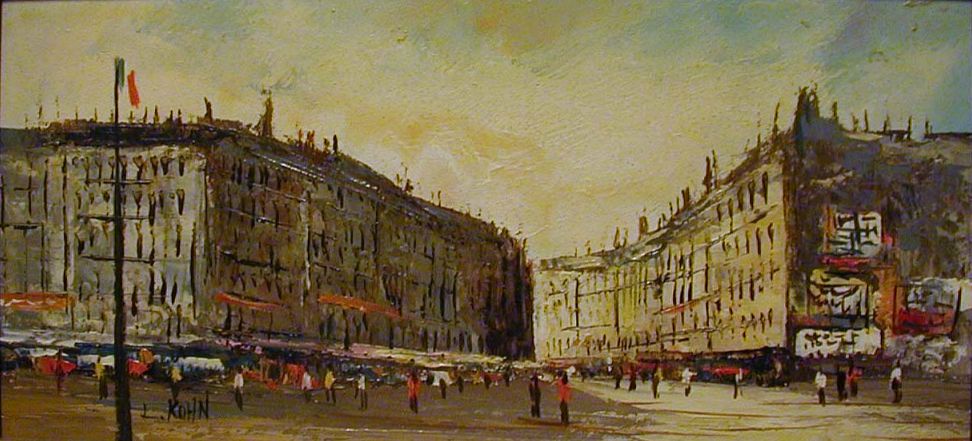
unnamed, L. Kohn, 4" x 9", oil
This is an ebay find. The
seller claimed it was the work of Ludwig Kohn and that
they had found two images of paintings with identical
signatures in old auction catalogs. That may or may
not be true, but I was fairly easily able to locate an
example of a work by Ludwig Kohn on the Internet and
the style and signature did not resemble the work of
this artists. Ludwig Kohn seems to have signed with
his full first name, not the initial "L". That being
said I like this artist's work. I suspect he or she
worked in Europe, possibly in France. I found another
work by and L. Kohn that reminds me of this artist's
style and the signatures are very similar, too.
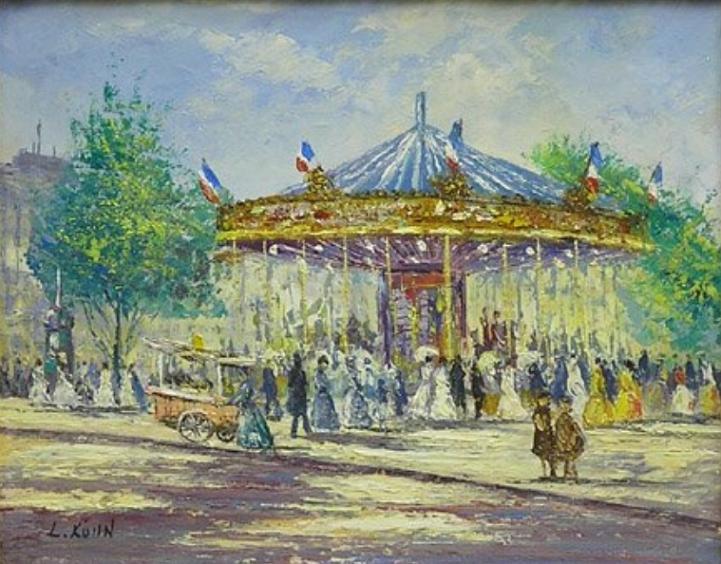
unnamed, L. Kohn, 8" x
10", oil
After a brief search, I was
able to locate works by at least three artists who
signed "L. Kohn". The styles and signatures of these
artists were very distinctive and different from one
another. The two works and signatures shown here
were the most similar and are quite possibly the
work of the same artist. The painting above, which I
call "The Gazebo" was sold at auction in the U.S.
and was described as French in origin. It was
exquisitely framed in an ornate gilt frame.
My painting is also very well
framed, though the frame was "Made in Japan". This
looks like 1950s or 1960s frame to me.

Label from my painting
My painting may be a bit
stained from cigarette smoke as evidenced by the
brown in the sky. It is very well done and has a
lot of depth for such a small work.


Comparison of
signatures

This was an ebay find. The
seller read the signature as Tinh, but it looks like
Linh, to me. The seller claimed this was among many
pieces of art that came from the "Violante estate".
The Violantes were reportedly artists, art collectors,
and patrons of the arts and other artists. There was
an August J. Violante 1906-2001 who was a San
Francisco commercial artist who is mentioned in
Hughes' California
Artists and Davenport's Art Reference and Price
Guide. I like the bright colors, motion, and
subject of this piece. No great hopes of finding out
more about this artist, as both Tinh and Linh are
common names.


"Forest Glen", P. Kirk, 23" x 27", watercolor
I have not been able to
discover anything about this artist. This painting was
purchased on ebay from a seller in Ormond Beach,
Florida in mid-2009. It has what appears to be a
gallery label verso that says "Kirkland Artists Group
Gallery", and information about the painting. I have
found no trace of this gallery or artists group.

verso
There is another painting on
the reverse. The painting was cardboard backed and may
date from the 1960s-1980s. Whoever filled out the
label misspelled "glen". Not a horrible painting, but
a disappointing research opportunity, so far. An
artists group that left no trace and an artist with a
very common name. Sigh.
Update: In October of 2010, I received the
following email:
"hello I may have some
info on the p kirk paintings I have 3 of them that my
great aunt had. 1 oil on canvas from peggy kirk 1005
104th s.e. bellevue, Wa 98004 455-9466 painting is
called california coast. also a small framed mix of
seven watercolors ocean theme, signed on back to my
great ant for being the best sunday school teacher
with her signature peggy kirch 1984. also have one
larger watercolor. hope this is a start if you would
like to find more info."
This would seem to resolve this
mystery and create another. Who was/is Peggy Kirk? I
found information about an artist of that name, in
that area, who is apparently still active, but have
not been able to contact her.


unnamed, unknown, 10.75" x 8", watercolor
I am not sure what to make of
this one. I purchased it out of curiosity on ebay from
a seller in California who had taken great pains to
archivally mat, clean, and re-back it in it's
original, well-made frame. I bought it during my
British 19th century watercolor collecting period and
was somewhat embarrassed (internally) by it in
comparison to those amazing works, but have come to
appreciate it for what it is. Whatever that is. LOL.
Judging by the frame and style of the work it has a
1950s feel to me. The artist obviously put a great
deal of effort into the painting and it feels like it
is based on a real place to me. It is signed with
either a complex monogram or a highly stylized
signature. If anyone recognizes this artist's mark I
would appreciate being educated about it.

I have seen one other painting by
the same artist, similarly signed. That one had an
inscription verso that read "Oct 1967 Granada Spain". I
was not able to get a very good image of the painting.

The image provided was very small
and partially cut off on one corner, so the image that
resulted from my editing is slightly out of proportion.
This appears to have been an accomplished and well
traveled artist. My painting has a vaguely Spanish feel to
it, too, but I had assumed it was a California scene, as
the seller was located in California. Help!


"Chertsey Lock & Weir", unknown, 5" x 7", watercolor and ink, 1888
A large number of these small
watercolors were offered by a seller the UK in 2007.
They came from the portfolio of an unknown artist. The
artist was quite chatty in his or her inscriptions on
the back of these paintings, apparently wanting to
commemorate each occasion. This one says "Chertsey
Lock & Weir" (in pencil) "from the boat moore to
Chertsey bridge.Tues Sep 11th .88" (in ink).
Some of these small paintings were very well done and
some a bit awkward. Likely the work of some Victorian
gentleman or lady of leisure, not a serious artist.

"View on the Hey", unknown, 5" x 7", watercolor and ink 1888
This one says on back in
pencil "View on the Hey abt 4 mile up from Thames
lock on the old river, through Bridge. St Gregory
Hill in distance. Saty Sep 15th/ 88.
None of these small works were
in any way signed. I don't expect to ever know any
more about this artist than I do at the present.

"Seascape No. 5", Jos. H. Sooy Jr., 16" x 20", pastel
Joseph H. Sooy Jr. was active
as an artist in the early 1960s, as indicated by
inscription on the back of this painting. He appears
to have been a serious artist who exhibited his work,
but has left no trace in CyberSpace or in print. I
have found no other mention of this artist or of his
work. I purchased this pastel on ebay from a seller in
California. She told me that the painting came from
Sacramento, CA. There are records of several men named
Joseph Sooy going back to pre-Revolutionary times in
New Jersey through the 1930 census. This artist may be
from that family. There were only two men named Joseph
Sooy in the 1930 census, though. One, named Joseph H.
Sooy, was born in 1910 and living with his parents in
Ocean City, New Jersey, a good candidate to Jos. H.
Sr. No Joseph H. Sooy is listed in the Social Security
Death Index, so this artist may still be among the
living.

Label, verso
What appears to be a gallery label is affixed to the backing of the painting with scotch tape. A fairly high number is assigned for the catalog number, so my guess would be that this label was from a gallery or some institution that was cataloging works shown over a specific period of time or in a very large show.

Inscription on old backing
Sooy had a very distinctive
signature, so it should not be hard to identify more
of his work if there is any out there. There appear to
have been at least four more "Seascapes". Luckily, the
old backing replete with all of the information it
contained survived. Even so, this artist made my
unknown artists page. Any information about Mr. Sooy
would be appreciated.


unnamed, unknown, 4"x 5", unknown
No idea what this is. It may
just be some Import/Export piece of junk, but it has
become one of my favorite things. The material appears
to be stone or organic, and has the feel of coral. I
am certain it is not resin. It has lots of
imperfections as may be seen in the image of the back.
It is also very nicely framed. It appears that it was
fashioned from a block of whatever material it is by
first grinding a flat surface, polishing it, and then
inscribing the image shown. I paid $2 or $3 for this
at Goodwill, and that may be it's cash value, but I
think it is fun. There is what may be a maker's mark
in the lower right corner. Any information about this
piece would be appreciated.


unnamed, ? Koppelmann, 8" x 10", oil
This painting came from a now
defunct wholesale art company, Personal Preference
Inc., that claimed to sell about 250,000 pieces of
quality art a year in the U.S. to institutions like
hotels. This company operated from the late 1970s
for thirty years. Their supplier, Just Better Art,
is supposedly taking over their business but their
web site is
very much under construction. I dropped them an
email in hopes that they may have information on
this artist since the piece has a serial number, but
received no response. It is a pleasant little oil
painting, did not cost much, and is providing me a
research opportunity. I like the colors, though it
is a bit pink.

Above is the label that is on the
back of this painting. Though small, it is an oil on
canvas. The frame is "Made in Mexico", common in the 1970s
and maybe 1980s. The most prominent artists of this name,
minus one of the trailing "n's" are Chaim and Dorothy
Koppelman. This does not bear any resemblance to their
work, though. No idea what the cryptic inscriptions in ink
mean. An Internet search turned up nothing.

Signature

unnamed, Huskej Wojcicki (?), 10" x 8", oil
Here is another painting from
the inventory of Personal Preference Inc. I paid $5 or
$10 for this at a used furniture store. I bought it as
part of my research into this company, but like like
the painting's colors and textures, too.

The label from the back of the
painting has some pretty clear notations and I
think may have the artist's name, though I am not
certain. No idea what "Thorson 230" means, though.
This one also has a frame that was made in Mexico,
so probably from the 1970s or 1980s. Any help on
these two is appreciated.


unnamed, unknown, 20" x 24", oil on canvas
I purchased this one on ebay
for a small amount. The seller could not read the
signature, but it looks like it may be a nice
painting. The proportions may be a bit off, but the
subject is pretty classic and has the added attraction
of a small dog near the two men. The seller's image
was very poor and he could not make out the signature
and his image of it is no help. I have massaged it
with the Gimp, but could not make it out either. I
have not received this painting, yet, and hope it
won't be a disappointment. I'll get better images when
it arrives.


unnamed, W. A. Still (?), 10" x 16", oil, 1961
I have no information about
this artist. This painting was purchased on ebay from
a seller in Pipersville, PA. The seller read the
signature as "W. H. Still". I read it as W. A. Still
from the signature on the front of the painting. The
seller's image was very blurry, but I took a chance
and put a small bid on it and won the auction. It came
framed in a surprisingly well made, and probably
expensive, sculpted frame. It is painted on masonite,
but had a heavy paperboard backing, close to what is
now called "chip board". I have never seen an oil
painting backed in this manner, but it gave the artist
a place to put the inscription shown below.

Notation, verso
The artist wrote and signed, "The
days grow shorter. Soon
each graceful swan will flex his pinions
southward.......and be gone". I think the artist was
proud of this painting. The artist did a pretty good
job of showing a flock of swans taking off from a
partially mist shrouded wetland marsh. I was a bit
surprised at the quality of this painting as the
seller did not comment on that or on the frame, both
good selling points. The seller sold several other
swam themed items at the same time as this painting
was sold, probably from the estate of someone with a
swan fetish. The signature verso looks much less like
"Still" to me, and more like "Actill", but is probably
stylized. I bought this one on impulse for very
little money as a research opportunity.

This
painting is very dirty as can be seen by the part of
the painting protected by the frame. In an attempt to
bring out the detail and true colors of this painting,
I photographed it in bright evening sunlight, with
mixed results. I think a little more detail is
visible, but the colors look a bit washed out.
Any help in identifying this artist
would be appreciated!


unnamed, N. Thomas, 24" x 36", oil on canvas
No idea who this artist is/was.
I found this in a central Illinois thrift shop for
$7.99. I really did not have room to hang it but it is
such an attractive painting, I was worried at what
it's fate would have been had I not purchased it. It
had been on the floor of the shop for just a few
minutes when I came in. This image really does not
capture how colorful this painting is, and how vibrant
the spots color are that are created by the nets
hanging over the wall of the dock and sides of the
ships. It also does not capture well the misty
background that accompanies this cloudy day. Not great
art, but very striking, anyway. It reminds me very
much of the Pacific Northwest's Puget Sound. It
appears to be at least 20 or 30 years old, so is not a
member of the flood of Chinese paintings of this size
that are so common nowadays. Not sure that is American
either, though. It is a bit better than the run of the
mill 1960s and 1970s European and Mexican sofa art
pieces, I think, but could well be of that ilk. I am
undecided if the yellow/brown in the center sky is
supposed to be sunlight behind the clouds or is the
result of having hung in a smoker's home for many
years. It does not smell like smoke... Any information
on this artist would be appreciated.


unnamed, Neufeld, 16" x 20", oil
This painting and an abstract
painting by the same artist were offered on ebay as
works by well known artist Woldemar Neufeld. I was
very skeptical that this was his work as it is nothing
like the style of the work of Neufeld that I have
seen, though the signature does bear a resemblance to
the last name in some that I have seen. Neufeld's
works, usually prints, sell for hundreds of dollars
into the low thousands so it seemed very unlikely that
I would be able to pay $22.50 for one on ebay. I bid
on it because I liked the colors and style and it was
cheap. It is painted on period Grumbacher canvas board
marked "Plyex". The abstract painting was done on
stretched canvas.
After the auction, I contacted the
seller (cherrynow), just to see why he thought this
was the work of Woldemar Neufeld. He replied that the
remains of Neufeld's estate had gone to a local dealer
in New Jersey. This seemed possible, as Woldemar's
widow, Peggy Woldemar, died in Oct 2008 in New
Milford, CT and I purchased this painting in February
of 2009. Her husband died in 2002. Woldemar Neufeld
was born in 1909, was married, and photos I have seen
of him generally agree with the appearance of the
subject, though no pictures show him with a mustache
or glasses. The subject is about the right age, race,
complexion, and wearing a wedding ring. Some things
about it bothered me, though. For instance, if the
artist was painting himself in a mirror, his wedding
ring would have appeared to be on his right hand, and
it is on the left hand of the subject in this
painting. I contacted the seller again via email and
asked for the name of the dealer he had purchased it
from and the date of purchase. He became very
defensive and said he could not share that information
because "it will reveal my source". LOL, now I smell
the skunk. I sent him another email and asked why it
would matter if I know his source? His response was
two words, "flea market" and in the next email he said
that the seller at the flea market got the remains of
Neufeld's estate. Not a real surprise that this was an
obvious lie, but this guy has over 600 feedbacks and
one negative in the past year. Why lie? Probably
because he was knowingly lying in his ebay description
by claiming this to be the work of Woldemar Neufeld as
opposed to someone named Neufeld, to try to make more
money. Classic. It took be about 20 minutes of
searching on Google to determine that Woldemar Neufeld
had a son, and to find his telephone number. Turns out
he had already seen this painting on ebay and
confirmed that it was not his father's work. He was
also the executor of his father and mother's estates
and told me that nothing from them had left the
family. So, the ebay seller turned out not only to be
dishonest, but lazy and inept, too, or he would have
found out how easy it would be for someone to find
this information. Another tidbit of information from
Mr. Neufeld's son for those interested in the work of
Woldemar Neufeld that is worth mentioning, is that his
father ALWAYS signed his first and last name, NEVER
just his last name on his work.
Still fun and colorful and cheap! I
am including the signature from the abstract painting
as another sample of this artist's signature. There is
a chance that they were actually done by an artist
named Neufeld and that they were not meant to deceive.
Any information about this artist would be
appreciated.

unnamed, Neufeld, 16" x 20", oil


unnamed, unknown, 22" x 28", oil
I don't often buy unsigned
paintings because it is usually very hard to find out
anything about them and it thwarts my enjoyment in
doing research. I am a sucker for winter paintings
though, especially colorful ones, so here we are. This
one was purchased by the previous owner at an estate
sale in Hopewell, NJ in early 2009 and described as in
the New Hope School style and guesstimated to be 1930s
vintage. I tend to agree on the age, judging by the
board it is painted on and the frame it is in. The
board is canvas board that has a built in paper
backing that is darkened and quite brittle. The scene
could certainly be 1930s-1950s. It is a mixture of
naive and fairly sophisticated painting, obviously
done by a painter of some experience, though perhaps
not formally trained. I don't have any hope that I
will be able to find out more about it. Just planning
to enjoy it on those hot, Midwestern July afternoons.

unnamed, unknown, 10" x 14", oil
I don't know anything about
these paintings. I am pretty certain they were painted
in Southeast Asia. I rode in similar three wheeled
bicycle taxis in Thailand and Vietnam. I suspect they
could also be found in Cambodia and Laos. I purchased
them from a lady who had inherited them from a
relative and knew nothing about them. The oil seems to
be painted on cloth that is laid on top of some sort
of mesh. It is by a different artist than the one who
did the watercolors.

unnamed, unknown, 10"
x 11", watercolor
This is a pretty classic scene
from anywhere in Southeast Asia. I suppose it could also
be the Philippines. These paintings are simple but very
nicely done and colorful. I like that they depict scenes
from everyday life. It reminds my of my time in Southeast
Asia.

unnamed, unknown, 11" x 10", watercolor
Again, nothing to show where
these were painted. I see a couple of different styles
of hats that were common in the Southeast Asian
countries where I lived. All three paintings are
signed, but I cannot read the signature and have not
been able to get a decent photo of the signature on
the oil. Any help on this one would be appreciated.
Hard to say how old they are. I would guess pre-1970s
and maybe older.



unnamed, A. N. Hordberg, 20" x 14", oil
A. N. Hordberg (or N. A. Hordberg!)
was an artist who painted marine scenes using oils in the
mid 20th century. The Hordberg name is exceedingly rare in
the US. have seen two other examples of this artist's
work, a 2 foot by 3 foot painting of a ship, which sold at
auction in Massachusetts for $690 in 2001 and an ocean
scene that sold for $275 in California. The painting in my
collection came from a dealer in Newark, Delaware. There
was an Albert Hordberg working at a school in Bridgeport,
Connecticut in 1920, the only Hordberg appearing in any US
census, aside from his wife and one child, though I have
found references to a handful of other folks with that
surname in more recent times, one, a Nancy Ann Hordberg
who was referenced in the records of the US Senate in
1979. Yeah, I am grasping at straws on this one.

A. N. Hordberg painting of
a brig, 2' x 3', sold at auction in 2001
The
quality and complexity of this artist's work suggests they
were a professional artist or very serious amateur. I do
not have much hope of finding out more about this artist
and welcome and help on this one! The artist has a very
distinctive signature.

A. N. "Hordbery", 23" x
27" including frame, oil, sold at auction in 2007
I included the frame in the image
of this painting to show how grandly this artist's work
has been treated in the few examples that I have seen.
The auction description of this work described it as
"European" and I was inclined to agree until I saw that
my painting had be done on an American manufactured
canvas board. The artist signed all three of these
paintings in the lower left corner.

A. N. Hordberg signature from my painting

unnamed, Tillett, 11.75" x 13", pastel
This artist is not yet
identified. The work is signed Tillett. It was framed
by a shop in Providence, RI. I thought this was really
well done. It also came professionally framed in a
very nice wooden frame. There was an artist and
gallery owner in St. Thomas named Jim Tillett who
passed away around 2000 who may be the creator of this
work.

unnamed, C. V. Gallup, 8.5"x 12.5", watercolor
The identity of C. V. Gallup is
a mystery, so far. This watercolor seems to date from
the first half of the 20th century, possibly the 1920s
or 1930s, or earlier. It is a very pleasant little
painting and reminds me of Monet's work a bit. It was
purchased from a dealer in New Jersey and I suspect
that the artist was from New England.
There was a Clara Virginia Gallup
in the 1900-1920 federal census records of New York
City. She was born on 31 January of 1848. She married
George Burr Floyd in 1868, but he was deceased in 1870
when she and her infant daughter, Julie Lilias, were
living with her parents, Kenney and Clara Cole
Couillard, in Westfield, New Jersey. Her father was a
well to do merchant as early as 1860, probably dealing
in liquor. Her father was deceased by 1870 when she
was living her mother and siblings in Manhattan. The
Couillards had servants in census records from
1860-1880. Clara's brother, Charles K. Couillard,
worked as a stock broker for many years. According the
to New York Social Register Clara married Charles
Henry Van Eversdyk Gallup on 24 November 1891 in New
York City. His occupation was listed as "Secretary" in
the 1900 census. A history of his family notes that he
was engaged in the crockery and railroad businesses in
Boston before moving to New York where he was also
engaged in business.
Her second husband died between
1900 and 1910 and she seemed to live genteel widowhood
afterward, living in hotels in 1910 and 1920 and
apparently traveling to Europe in 1913 and 1923. That
she is the artist is a complete guess on my part,
though a near neighbor of her's in 1920 was employed
as a commercial artist. Though Gallup is a more common
name than one might think, this is the only candidate
I found for C. V. Gallup between 1880 and 1930.
Any information on this artist
would be appreciated.


unnamed, C. S. J. Prince, 6.75" x 9.5", watercolor, '55 (1955)
Here is a nice mystery. I like
the muted colors and quaintness of the scene. I was
not sure where the scene in this painting was located,
I guessed India or Southeast Asia. I was contacted by
the owner of another painting by this artist and he
sent me an image that seems to be of an Indian market
scene, so I guess I'll go with India on this one. The
other painting was not dated, or rather it appears
that the date was partly trimmed off, but the
signature was much more clear than the signature on my
painting which is obscured by the darkness of the
surrounding watercolors. I think I can make out enough
of the date to guess that it was painted in the 1940s.
This artist is not mentioned in any art reference book
that I have searched. I suspect that this is artist
was a talented amateur who possibly lived in India in
the 1940s and 1950s. Any information on this artist
very welcome.
An update on this artist: I was
contacted by a lady from the UK who has a much more
clearly signed painting, which also includes the
following notation verso:
CSJ Prince (signature)
c/o Rev. Z. S. Jeeraneson
United Theological College
17 Millers Road
Bangalore. I
So, it appears that this artist
did spend time in India. The scene in the painting
bearing this inscription is also an Indian village
scene, though in a somewhat looser style than the
other two paintings. I did a Google search on the name
Jeeraneson and came up completely empty, though the
owner of this painting is positive that, that is the
name. It is possible that the artist was somehow
affiliated with this college, or perhaps just a
personal friend of Mr. Jeeraneson.


Cernay-la-ville, L. B. Mathews, 10" x 12", August 1891
The Maine art dealer that I
bought this painting from was selling it as a French
painting, but I think it is probably by an English
artist of a scene in France. The seller also
interpreted the signature as Y. B. Mathews, but I
think it may actually be L. B. Mathews and possibly by
Mrs. Lydia B. Mathews who was active about this time.
This church is much painted and photographed but
typically not from this odd angle which is why I like
it. The frame and glass also appear to be original and
are very nice, too. The painting is thoroughly glued
to a card so we will never know if there are any clues
on the back of the painting. Until I can find some
justification for putting it in the "British Artists"
section, I will leave it here. Opinions on the
signature and origins are welcome!


unnamed, Leo(?) Gaind(?), 12.75" x 9.75", watercolor
I have not been able to
identify the artist of this whimsical Peruvian scene,
yet. At least my guess is Peru. I wonder if similar
scenes might not be found in other parts of what once
was the Inca empire in Ecuador and Bolivia? I did find
a few images of similarly dressed women in street
scenes of Cuzco, Peru using Google Images. There were
also similarly constructed balconies in some of these
images. The buildings in this painting certainly give
the impression that they are built on the ruins of
Inca foundations. I am including and image of the
signature below. Probably for the tourist trade. I
like the whimsy, color, and artist's use of shadow and
blowing snow in this painting. Nicely done scene of a
cold, breezy winter morning in the narrow city streets
of a South American city. I'd appreciate an help in
identifying this artist.


unnamed, T. Piasetzky, 10" x 13", watercolor/gouache
I have been able to find out
nothing about T. Piasetzky. This painting came from a
shop in Winnipeg, Manitoba, Canada. It looks like it
is maybe from the 1930s or 1940s. I bought it because
I like a challenge and it is a winter picture, but
this one has me stumped. While maybe not great art, it
seems obvious that this artist was talented and also
had probably been painting for some time when this
painting was done. I am guessing that this artist may
have been a logger or someone connected with that
trade who filled their down time with painting. This
seems to be a fairly classic scene. I have found
other, similar paintings by different artists, down to
the different colored horses. Any information on T.
Piasetzky would be most appreciated.
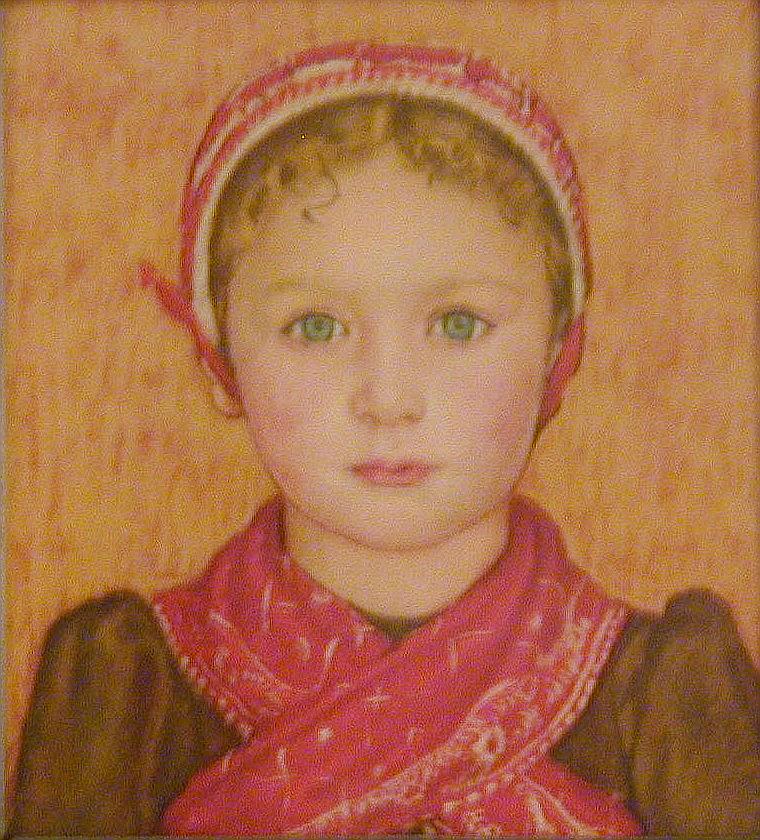
unnamed, F. d(under frame), 3.5" x 3.5", watercolor
I found this little gem at a junk shop a few blocks from my home. This store had a real mix of treasure and trash. I think it was operated by some organization composed primarily of WWII aged folks, as the volunteers there were that age and many of the items date from that period as well. I found several pieces of nice factory art glass there dating from the '40s - 60's, just the kind of stuff that would have been in the better stores during that time and then sold as the owner's estates were liquidated. I suspect this small painting may have been brought back from Amsterdam by a WWII soldier. The shop is gone now, so too late to find out for sure. I'd have to call this one of the treasures that the store carried. It is signed, but the signature is mostly under the frame and it is so beautifully framed and backed that I don't want to take this one apart. I call this one "Amsterdam Girl" as the label on the back has the name and address of a store named Kunsthandel Koch located in that city. This gorgeous little painting is so small that I could not get decent images of it with my camera. The colors are brighter and the image crisper than I was able to capture. I was contacted in 2009 by a gentleman living in Europe who had seen this painting in Europe in the 1930s, but could not remember where. He was even able to describe the frame that it is in. We corresponded for a time, while he was trying to remember where he had seen it, and then I heard no more from him. A small mystery.
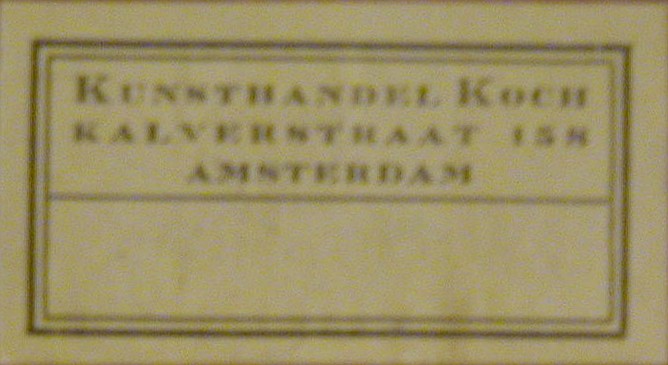

"The Yellow Sail", Rachel Grainger-Hunt, 9.5" x 12" , oil on board
Rachel Grainger-Hunt was
supposedly a mid to late 20th century painter in oils
who painted in several different styles from realism
to abstract. Originally I was told by the seller of
these paintings that her personal effects consisting
of several chests were purchased by an art dealer from
an estate liquidator in Cork, Ireland though she may
or may not have been Irish. The estate liquidator did
not attempt to preserve or discover any information
about Ms. Grainger-Hunt. Included in her effects were
personal items besides her paintings which indicated
that she had lived for some time in South America. The
titles of some of her paintings also indicated that
she spent time in various parts of Europe. Included in
her artwork were a dozen or so large canvases that
were signed with her full name, last name hyphenated.
She signed most of her work with her initials "RGH".
There is some inference that she may have been married
to an artist named Terry or Gerry Hunt, though this is
not certain and there is no information available
about Mr. Hunt.

"Church and Hayfield, Sussex", 11" x 15", oil on board
Later the seller of these
paintings said he had discovered that Ms.
Grainger-Hunt was still living and painting. The
seller started offering new paintings by her and
hyping her work as a hot commodity, though the
paintings generally sell for small amounts. The seller
now refuses to give any more information about Ms.
Grainger-Hunt's background or whereabouts. This may be
a scam but many of the paintings are attractive and
cheap so no great loss if this is a scam, though buyer
beware!

"After Church, Hull", 10" x 12.5", oil on board
As some of these paintings are very well done, it has also occurred to me that they may be the experimental or practice works of a well known or professional artist who does not want to sign their real name to them. A mystery.

unnamed, M. Matsu, 9.5" x 13", watercolor
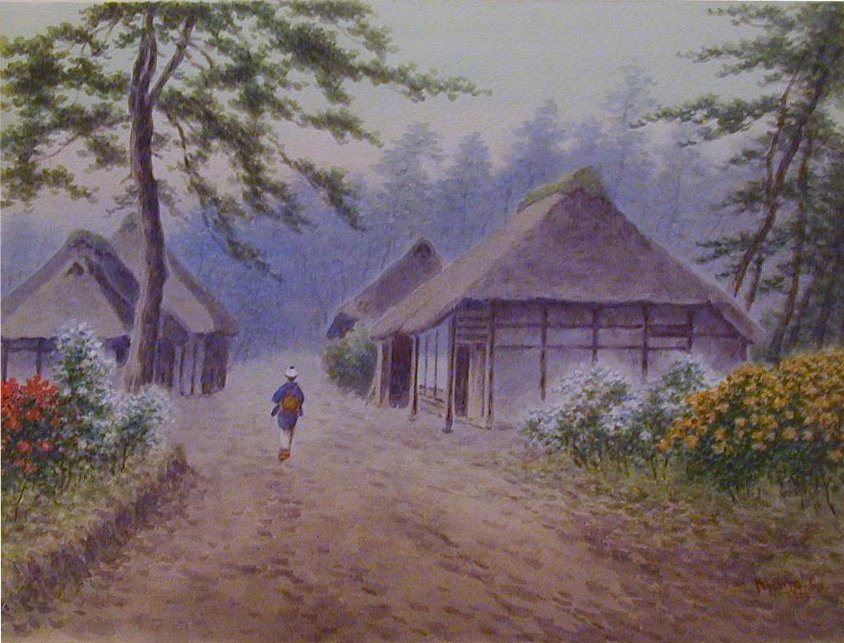
unnamed, M. Matsu, 9.5" x 13", watercolor
The first image is of the Itsukushima Shrine at Miyajima. These are very nice. Here is a good site to find out more about Japanese watercolors and woodblock prints.

unnamed, S. Nimi, 9.5" x 13.25", watercolor
S.
Nimi
was
another
pre-WWII
Japanese
artist
and
he
is
as
mysterious
as
Mr.
Matsu.
I
actually
found
this
one
in
a
little
antique
mall
about
6
or
8
blocks
from
my
house
for
$10.
The
label
and
mounting
tape
are
from
an
art
shop
that
has
probably
not
existed
for
50
or
60
years.
Note
that
the
name
and
address
of
the
art
store
are
different
on
the
label
that
was
on
the
back
of
the
painting
and
on
the
tape
that
was
used
to
mount
the
painting
to
the
mat.
Springfield
is
about
60
miles
from
the
town
where
I
live.
I
suspect
that
this
painting
has
an
interesting history. It appears to have been
matted at least twice, and perhaps three times
judging by the mat burns. The frame may be
original as it is bamboo and very old, though
still sound. I matted it to show the history of
the painting, though I guess someone in the
future may decide to hide it. Either way it is
nice painting. Not bad for ten bucks.


"Place du Tertre, Paris" , Séguié, 9" x 11.5", watercolor

unnamed, Séguié, 9" x 11.5", watercolor
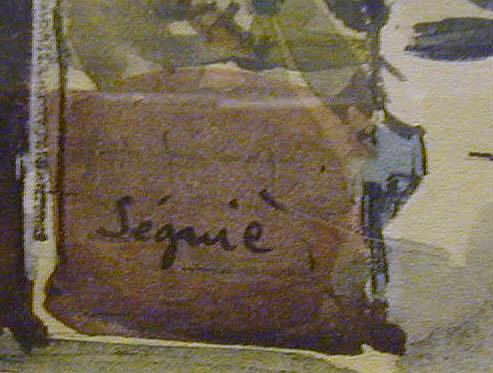


unnamed, G. Deschamps, 5" x 5", oil on board
This was one of a pair
of small paintings offered on ebay. I guessed
that the signature was "T. Deschamps". The
paintings were in similar frames. I was
contacted by someone who is familiar with the
place pictured in my painting and they told me
it was the Tour Solidor in Saint-Servan, a
suburb of Saint-Malo, Brittany, France.

Signature from my painting

My painting, framed
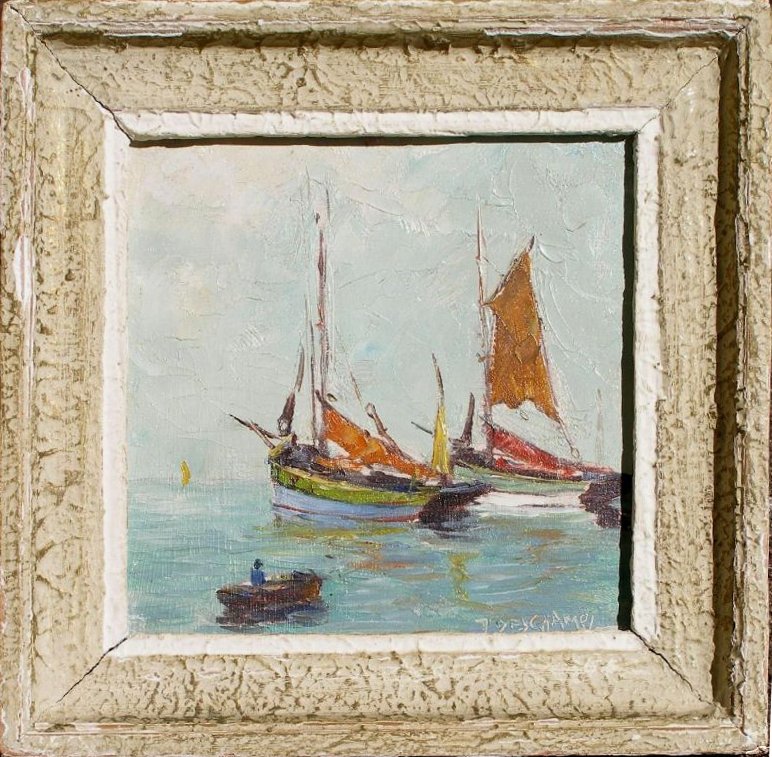
Mate to my painting
Luckily, I was able to find
two other paintings that lead me to believe that
this is the work of G. Deschamps, a French
painter. Both of the other paintings are very
similar in style and subject to the two paintings
above. The first of these paintings bears a
signature that is very similar to the one on my
painting and its mate. Luckily, this painting has
a label with the artist's name and address, and
title of the painting.
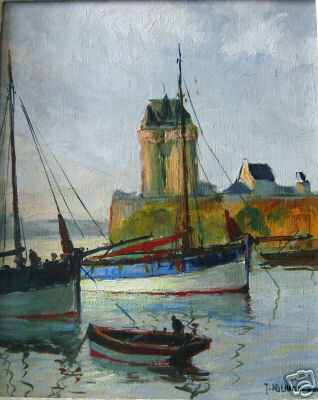


Deschamps painting
three, framed and label
This painting appears to be very similar in style,
and the frame also has similarities to the first
two paintings. The signature on the label, verso,
appears to be G. Deschamps, and address "1 Place
Porte de Chatillon, Paris". The signature on the
front of the painting also appears to be very
similar to the signatures on the first two
paintings. Note the title, St Servan y Mer, Tour
Solidor, the same location as my painting.



G. Deschamps painting #4 framed painting, label and signature
Painting number four is similar in style and
subject matter to the first three paintings, had
a label with the same name and address as
painting number three, but a signature that is
very different from all of the others. It may be
that the artist's signature changed, or that
related artists were working from the same
address, working in the same style. Painting
four is clearly signed "G. Deschamps". The
address is a big clue to the identity of this
artist, but unfortunately I do not have the
resources to determine which artist named
Deschamps lived there.

unnamed, Brauer, 13.5" x10.5", gouache, dated 1935
Brauer was supposedly a German artist who was active 1920-1940, a friend and peer of fellow artist Willibald Hamburger. Hamburger painted in the German symbolit style. So far, I have been unable to find out much about either man.
Here are some artists whose work I really like but have not yet added to my collection:
Michael McKee Michael does beautiful work with pastels.
- On line appraisal service
from John Sewell well known Canadian expert on
fine art and antiques. This is a very reasonably
priced on line service from a well respected
expert. Fill out an on line form and send images
of your art objects. No need to send your art
objects through the mails. I am a satisfied
customer! Highly recommended!
- Here is a list of common British art society abbreviations.
- Images
of art works by 29,000 artists. I use this site
to compare works that I am interested in or own
to other works by the same artist. A good place
to spend some time just cruising, too!
Pennsylvania Artists Texas Artists New England Artists Other Artists
UK Artists Canadian Artists South American Artists Asian Artists European Artists
Unknown Artists Unknown Artists 1 Unknown Artists 2 Unknown Artists 3
HOME